-
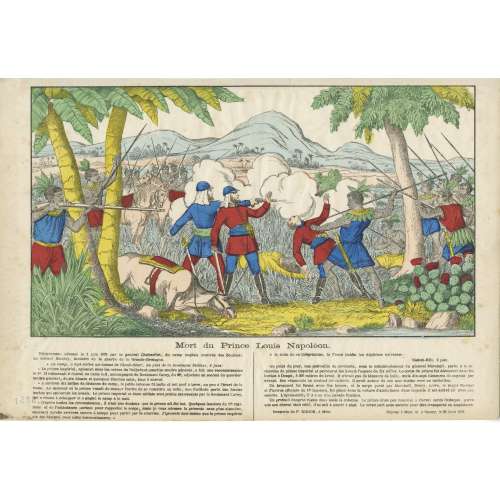 Hand-coloured woodcut on wove paper, 267 x 390 mm. On reverse: black ink stamp “5351”. Centre, under the image frame "Mort du Prince Louis Napoléon". Below left: "Télégramme adressé le 2 juin 1879 par le général Chelmsfort, du camp anglais (contrée des Zoulous), au colonel Stanley, ministre de la guerre de la Grande-Bretagne. « Au camp, à sept milles au-dessus de Blood-River, au pied de la montagne Stellezi, 2 juin: Le prince impérial, agissant sous les ordres de l'adjudant quartier-maitre général. a fait une reconnaissance le 1er. Il retournait à cheval au camp le 2 accompagné du lieutenant Carey, du 98e adjudant en second du quartier-maitre général. de six blancs et, quelques Zoulous amis, tous à cheval. A environ dix milles de distance du camp, la petite colonne fit halte at mit pied à terre, un peu à l’écart de la route. Au moment ou le prince venait de donner l'ordre de se remettre en selle. une fusillade partit des hautes herbes qui entourant les kraals. Le prince impérial et deux soldats sont portés manquants par le lieutenant Carey, qui a réussi à échapper et a gagné le camp à la nuit. D'après toutes les circonstances, il 'est pas douteux quo le prince ait été tué. Quelques lanciers du 17 régiment et de l'ambulance partent pour rapporter le corps; mais je vous adresse la présente sans plus attendre, espérant qu'elle arrivera encore à temps pour partir par le courrier. J’ignorais moi-même que le prince impérial eût été désigné pour cette reconnaissance. »" Below right: A la suite de le télégramme, le Times publie les dépêches suivantes: Stelezi-Hill, 2 juin. Au point du jour, une patrouille de cavalerie, sous le commandement du général Marshall. partit à la recherche du prince impérial et parcourut les kraals l'espace de dix milles. Le corps du prince fut découvert dans les herbes à Donga, à 300 mètres du kraal. Il n'avait pas de blessure de balle, mais dix-sept blessures de zagaies par devant. Ses vêtements lui avaient été enlevés. I avait autour du cou une chaine avec un médaillon. Un brancard fut formé avec les lances, et le corps porté par Marchall, Drury, Lowe, le mjor Stewart et d'autres officiers du 17e lanciers, fut. place dans la voiture d'ambulance dans laquelle il est arrivé ici avec une escorte. L'après-midi, il v a eu une parade funèbre. Un profond chagrin règne dans toute la colonne. Le prince n'est pas remonté à cheval après l’attique, parce que son cheval était rétif ; il se mit à courir à pied. Le corps part sous escorte pour être transporté en Angleterre. Bottom right: "Imagerie de P. DIDION, à Metz — Déposé à Metz et à Nancy, le 25 Juin 1879". Paulin Didion (French, 1831 – 1879) – publisher/printer.
Hand-coloured woodcut on wove paper, 267 x 390 mm. On reverse: black ink stamp “5351”. Centre, under the image frame "Mort du Prince Louis Napoléon". Below left: "Télégramme adressé le 2 juin 1879 par le général Chelmsfort, du camp anglais (contrée des Zoulous), au colonel Stanley, ministre de la guerre de la Grande-Bretagne. « Au camp, à sept milles au-dessus de Blood-River, au pied de la montagne Stellezi, 2 juin: Le prince impérial, agissant sous les ordres de l'adjudant quartier-maitre général. a fait une reconnaissance le 1er. Il retournait à cheval au camp le 2 accompagné du lieutenant Carey, du 98e adjudant en second du quartier-maitre général. de six blancs et, quelques Zoulous amis, tous à cheval. A environ dix milles de distance du camp, la petite colonne fit halte at mit pied à terre, un peu à l’écart de la route. Au moment ou le prince venait de donner l'ordre de se remettre en selle. une fusillade partit des hautes herbes qui entourant les kraals. Le prince impérial et deux soldats sont portés manquants par le lieutenant Carey, qui a réussi à échapper et a gagné le camp à la nuit. D'après toutes les circonstances, il 'est pas douteux quo le prince ait été tué. Quelques lanciers du 17 régiment et de l'ambulance partent pour rapporter le corps; mais je vous adresse la présente sans plus attendre, espérant qu'elle arrivera encore à temps pour partir par le courrier. J’ignorais moi-même que le prince impérial eût été désigné pour cette reconnaissance. »" Below right: A la suite de le télégramme, le Times publie les dépêches suivantes: Stelezi-Hill, 2 juin. Au point du jour, une patrouille de cavalerie, sous le commandement du général Marshall. partit à la recherche du prince impérial et parcourut les kraals l'espace de dix milles. Le corps du prince fut découvert dans les herbes à Donga, à 300 mètres du kraal. Il n'avait pas de blessure de balle, mais dix-sept blessures de zagaies par devant. Ses vêtements lui avaient été enlevés. I avait autour du cou une chaine avec un médaillon. Un brancard fut formé avec les lances, et le corps porté par Marchall, Drury, Lowe, le mjor Stewart et d'autres officiers du 17e lanciers, fut. place dans la voiture d'ambulance dans laquelle il est arrivé ici avec une escorte. L'après-midi, il v a eu une parade funèbre. Un profond chagrin règne dans toute la colonne. Le prince n'est pas remonté à cheval après l’attique, parce que son cheval était rétif ; il se mit à courir à pied. Le corps part sous escorte pour être transporté en Angleterre. Bottom right: "Imagerie de P. DIDION, à Metz — Déposé à Metz et à Nancy, le 25 Juin 1879". Paulin Didion (French, 1831 – 1879) – publisher/printer. -
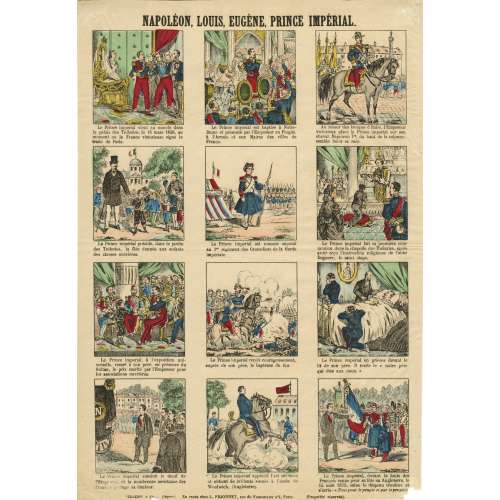 Hand-coloured woodcut on wove paper, 400 x 277 mm. Top: "NAPOLÉON, LOUIS, EUGÈNE, PRINCE IMPÉRIAL"; bellow 12 captioned frames:
Hand-coloured woodcut on wove paper, 400 x 277 mm. Top: "NAPOLÉON, LOUIS, EUGÈNE, PRINCE IMPÉRIAL"; bellow 12 captioned frames:- Le Prince impérial vient au monde dans le palais des Tuileries, le 16 mars 1856, au moment où la France victorieuse signe le traité de Paris.
- Le Prince impérial est baptisé à Notre-Dame et présenté par l'Empereur au Peuple, à l’Armée et aux Maires des villes de France.
- Au retour des troupes d'Italie, l'Empereur victorieux place le Prince impérial sur son cheval. Napoléon Ier, du haut de la colonne, semble bénir sa race.
- Le Prince impérial préside, dans le jardin des Tuileries, la fête donnée aux enfants des classes ouvrières.
- Le Prince impérial est nommé caporal au 1er régiment des Grenadiers de la Garde impériale.
- Le Prince impérial fait sa première communion dans la chapelle des Tuileries, après avoir reçu l'instruction religieuse de l'abbé Deguerry, le saint otage.
- Le Prince impérial, à l'exposition universelle, remet à son père. en présence du Sultan, le prix mérité par l'Empereur pour les associations ouvrières.
- Le Prince impérial reçoit courageusement, auprès de son père, le baptême du feu.
- Le Prince impérial en prières devant le lit de son père. Il récite le « notre père qui ètes aux cieux. »
- Le Prince impérial conduit le deuil de l'Empereur, et la nombreuse assistance des Français portage sa douleur.
- Le Prince impérial apprend l’art militaire et obtient de brillants succès à l'écolo de Woolwich, (Angleterre).
- Le Prince impérial, devant la foule des Français venus pour sa fête en Angleterre, le 15 out 1873, salue le drapeau tricolore et s'écrie : « Tout pour le peuple et par le peuple… »
-
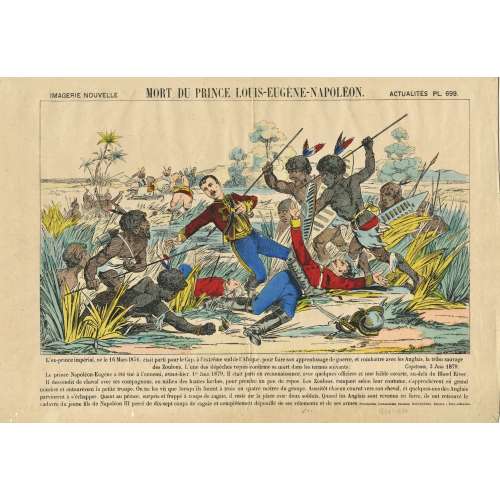 Hand-coloured lithography on wove paper, 275 x 385 mm; vertical centerfold, image in frame. On reverse: black ink stamp “5350”. Above the frame: "IMAGERIE NOUVELLE — MORT DU PRINCE LOUIS-EUGÈNE-NAPOLÉON. — ACTUALITÉS PL. 699". Under the frame: "L'ex-prince impérial, né le 16 Mars I856, était parti pour le Cap, à l'extrême sud de l'Afrique, pour faire son apprentissage de guerre, et combattre avec les Anglais, la tribu sauvage des Zoulous. L'une des dépêches reçues confirme sa mort dans les termes suivants: — Capetown, 3 Juin 1879. — Le prince Napoléon-Eugène a été tué à l'ennemi, avant-hier, 1er Juin 1879, Il était parti en reconnaissance, avec quelques officiers et une fable escorte, au-delà du Blood River. Il descendit de cheval ave ses compagnons, au milieu des hautes herbes, pour prendre un peu de repos. Les Zoulous, rampant selon leur coutume, s'approchèrent en grand nombre et entourèrent la petite troupe. On ne les vit que lorsqu' ils furent à trois ou quatre mètres du groupe. Aussitôt chacun court vers son cheval, et quelques-uns des Anglais parvinrent à s'échapper. Quant au prince, surpris et frappé à coups de zagaie, il resta sur la place avec deux soldats. Quand les Anglais sont revenus en force, ils ont retrouvé le cadavre du jeune fils de Napoléon III percé de dix-sept coups de zagaie et complétement dépouillé de ses vêtements et de ses armes". — "Typographie, Lithographie, Imagerie, Haguenthal, Éditeur à Pont-à-Mousson". Pencil ms: "1860-1880". Élie Haguenthal (French, 1822 – 1881) – publisher/printer.
Hand-coloured lithography on wove paper, 275 x 385 mm; vertical centerfold, image in frame. On reverse: black ink stamp “5350”. Above the frame: "IMAGERIE NOUVELLE — MORT DU PRINCE LOUIS-EUGÈNE-NAPOLÉON. — ACTUALITÉS PL. 699". Under the frame: "L'ex-prince impérial, né le 16 Mars I856, était parti pour le Cap, à l'extrême sud de l'Afrique, pour faire son apprentissage de guerre, et combattre avec les Anglais, la tribu sauvage des Zoulous. L'une des dépêches reçues confirme sa mort dans les termes suivants: — Capetown, 3 Juin 1879. — Le prince Napoléon-Eugène a été tué à l'ennemi, avant-hier, 1er Juin 1879, Il était parti en reconnaissance, avec quelques officiers et une fable escorte, au-delà du Blood River. Il descendit de cheval ave ses compagnons, au milieu des hautes herbes, pour prendre un peu de repos. Les Zoulous, rampant selon leur coutume, s'approchèrent en grand nombre et entourèrent la petite troupe. On ne les vit que lorsqu' ils furent à trois ou quatre mètres du groupe. Aussitôt chacun court vers son cheval, et quelques-uns des Anglais parvinrent à s'échapper. Quant au prince, surpris et frappé à coups de zagaie, il resta sur la place avec deux soldats. Quand les Anglais sont revenus en force, ils ont retrouvé le cadavre du jeune fils de Napoléon III percé de dix-sept coups de zagaie et complétement dépouillé de ses vêtements et de ses armes". — "Typographie, Lithographie, Imagerie, Haguenthal, Éditeur à Pont-à-Mousson". Pencil ms: "1860-1880". Élie Haguenthal (French, 1822 – 1881) – publisher/printer. -
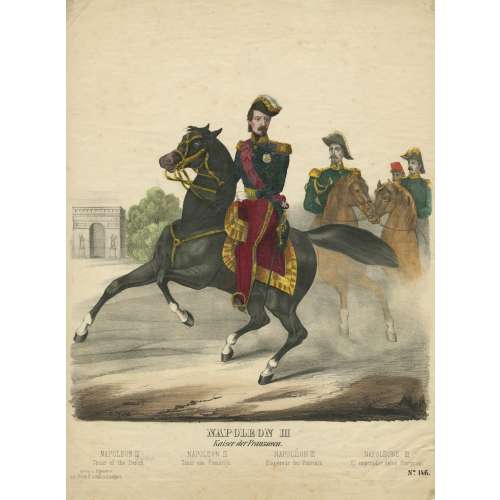 Hand-coloured lithography on wove paper 423 x 332 mm; On reverse: black ink stamp “4956”, ms “A”, ms pencil “428” and “Ernest”. Under the image, centre: "NAPOLEON III | Kaiser der Franzosen." Velow: | NAPOLEON III | Czaar of the French — NAPOLEON III | Czaar van Frankrijk — NAPOLÉON III | Empereur des Francais. — NAPOLEONE III | El emperador delos Franceses; bottom left: "Verlag u. Eigenthum | von. Fried. G. Schulz in Stuttgart.", right: "No 146." The artist's and printer's names in stone are not legible. Published in Stuttgart by Friederich Gustav Schulz (German, 1786 – 1859) during the time of the Second French Empire (1852-1870).
Hand-coloured lithography on wove paper 423 x 332 mm; On reverse: black ink stamp “4956”, ms “A”, ms pencil “428” and “Ernest”. Under the image, centre: "NAPOLEON III | Kaiser der Franzosen." Velow: | NAPOLEON III | Czaar of the French — NAPOLEON III | Czaar van Frankrijk — NAPOLÉON III | Empereur des Francais. — NAPOLEONE III | El emperador delos Franceses; bottom left: "Verlag u. Eigenthum | von. Fried. G. Schulz in Stuttgart.", right: "No 146." The artist's and printer's names in stone are not legible. Published in Stuttgart by Friederich Gustav Schulz (German, 1786 – 1859) during the time of the Second French Empire (1852-1870). -
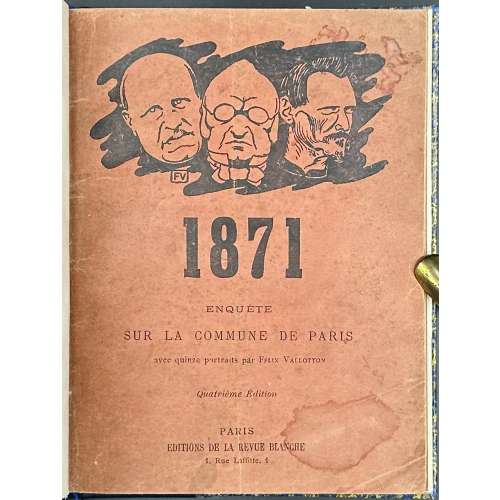 Hardcover, 20.2 x 15.5 cm, owner’s half blue morocco binding over marbled boards with gilt lettering to spine, marbled endpapers, extracts from La Revue Blanche, numbers 91 and 92 of March 15 and April 1 of 1897 (année VII, tome XII), publisher’s pink wrappers preserved, pp. [2] [1-5] 6-160. Ref.: Bridget Alsdorf. Vallotton, Fénéon, and the Legacy of the Commune in Fin-de-siècle France. Portraits: François [Quico] Merlin Colonel Merlin (French, 1814 – 1900) Adolphe Thiers (French, 1797 – 1877) Commandant Gaveau Fortuné Henry (French, 1821 – 1882) Otto von Bismarck (German, 1815 – 1898) Henri, comte de Chambord (French, 1820 – 1883) Louis Rossel (French, 1844 – 1871) François Huet Tranquille (French, 1842 – after 1879) Joseph Vinoy (French, 1803 – 1880) Raoul Rigault (French, 1846 – 1871) Eugène Varlin (French, 1839 – 1871) Théophile Ferré (French, 1845 – 1871) Georges Darboy (French, 1813 – 1871) Auguste Vermorel (French, 1841 – 1871) Jaroslaw Dombrowski [Jarosław Dąbrowski] (Polish-French, 1836 – 1871) Contributors: Félix Fénéon (French, 1861 – 1944) Félix Vallotton (French, 1865 – 1925) La Revue Blanche (Paris) Imprimerie Alcan-Lévy
Hardcover, 20.2 x 15.5 cm, owner’s half blue morocco binding over marbled boards with gilt lettering to spine, marbled endpapers, extracts from La Revue Blanche, numbers 91 and 92 of March 15 and April 1 of 1897 (année VII, tome XII), publisher’s pink wrappers preserved, pp. [2] [1-5] 6-160. Ref.: Bridget Alsdorf. Vallotton, Fénéon, and the Legacy of the Commune in Fin-de-siècle France. Portraits: François [Quico] Merlin Colonel Merlin (French, 1814 – 1900) Adolphe Thiers (French, 1797 – 1877) Commandant Gaveau Fortuné Henry (French, 1821 – 1882) Otto von Bismarck (German, 1815 – 1898) Henri, comte de Chambord (French, 1820 – 1883) Louis Rossel (French, 1844 – 1871) François Huet Tranquille (French, 1842 – after 1879) Joseph Vinoy (French, 1803 – 1880) Raoul Rigault (French, 1846 – 1871) Eugène Varlin (French, 1839 – 1871) Théophile Ferré (French, 1845 – 1871) Georges Darboy (French, 1813 – 1871) Auguste Vermorel (French, 1841 – 1871) Jaroslaw Dombrowski [Jarosław Dąbrowski] (Polish-French, 1836 – 1871) Contributors: Félix Fénéon (French, 1861 – 1944) Félix Vallotton (French, 1865 – 1925) La Revue Blanche (Paris) Imprimerie Alcan-Lévy -
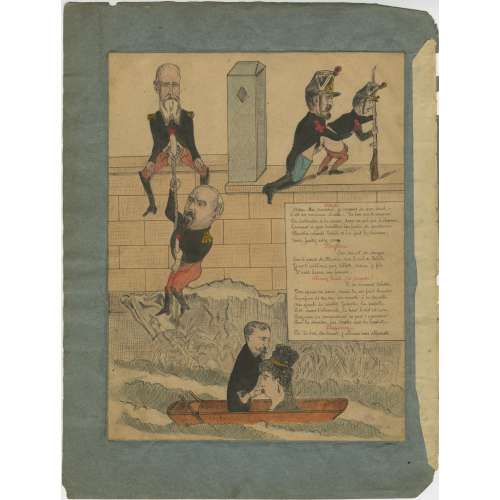 A series of seven political caricatures with indecent content, ink and pigment on paper, bound in a grey-blue folder. Each drawing is pasted to a grey-blue sheet of paper 32 x 24 cm. PLATES: 1) Villette; Bazaine; Alvarez Rull: 250 x 192 mm
A series of seven political caricatures with indecent content, ink and pigment on paper, bound in a grey-blue folder. Each drawing is pasted to a grey-blue sheet of paper 32 x 24 cm. PLATES: 1) Villette; Bazaine; Alvarez Rull: 250 x 192 mm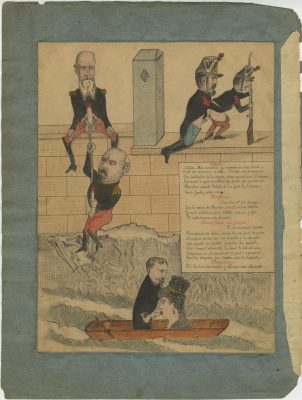
Villette Adieu, cher maréchal, je réponds de mon dard C’est un morceau d’acier… Là bas, sur le rempart, Sa cartouche à la main, dans un cul qui le charme, Lançant à gros bouillons son foutre de gendarme Plantin plante Delille et lui font le Caisson. Bazaine Sur ton vit de dragon Sur le nœud de Plantin, sur le cul de Delille, Je ne t’oublierai pas, Villette, adieu, je file Et je vais baiser ma femme. Alvarez Rull (à Josépha) Il ne saurait tarder, Ton epoux va venir, mais tu me fais bander, Le parfum de ton con me monte à la cervelle, Ma gaule se raidit . Josépha, la nacelle Est dans l’ obscurité, là haut, le ciel est noir, Bazaine en descendant ne peut t’ apercevoir … Pour la dernière fois, torche moi la houlette. Bazaine Eh ! là bas, du canot, j’allume une allumette!
Villette Farewell, dear Marshal, I vouch for my dick. It’s like a steel rod … Over there, on the ramparts, Plantin, his dick in hand, pounds Delisle’s beckoning ass And fills it with his bubbling gendarme’s cum. Bazaine For your dragoon’s dick, For Plantin's prick, for Delisle's ass, I won't forget you, Villette, goodbye, I'm leaving And I'm going to fuck my wife. Alvarez Rull (to Josépha) Hurry up, Your husband is coming, but I got a hard on you, The scent of your cunt penetrates my brain, My rod stiffened. Josépha, the gondola Is in the dark, the sky is black, Bazaine coming down and cannot see you... Give me one last blowjob.Bazaine Hey! Over there, from the canoe, I light a match!
French marshal Achille Bazaine capitulated to Bismarck during the Franco-Prussian war on 27 October 1870. In 1873, he was tried for treason and received a death sentence, later commuted to 20 years' imprisonment. Bazaine was incarcerated in the Fort Royal on Île Sainte-Marguerite, from which he escaped on August 9–10, 1874, with the help of Colonel Villette [Willette], his wife Josefa [Pepita Peña], and her nephew Alvarez Rull. They sailed to Genoa in Italy and from there to London. Plantin and Delisle were prison guards. The story was described in detail during the Trial of Col. Villette and his Accomplices in 1874 and published later in Robert Christophe. La Vie tragique du maréchal Bazaine. — Paris: Vautrain Jacques, 1947.
2) Impératrice Eugénie: 218 x 165 mm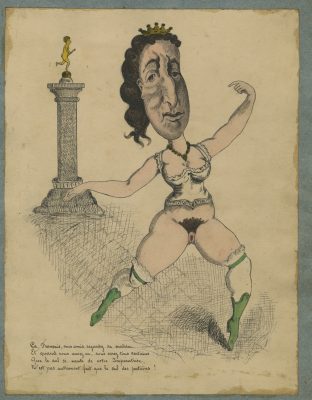
Ça, Français, mes amis, regardez sa matrice, Et quand vous aurez vu, vous serez tous certains Que le cul si vanté de votre Impératrice, N’est pas autrement fait que le cul des putains!
That, French, my friends, look at her cunt, And when you have seen, you will all be certain That the so acclaimed ass of your Empress, Is no different than the ass of whores! 3) Napoléon III: 215 x 168 mm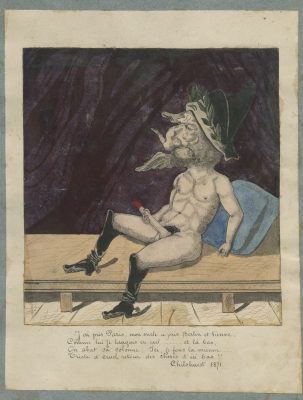
J’ai pris Paris, mon oncle a pris Berlin et Vienne. Comme lui je languis en exil …… et là bas, On abat sa colonne; Ici, je fous la mienne…. Triste et cruel retour des choses d’ici bas!! Chilshurst 1871. [i.e. Chislehurst]
I took Paris, my uncle took Berlin and Vienna. Like him, I, too, languish in exile. His column there was demolished; I’m jerking mine off here…. Cruel and sorrowful deeds!! 4) La confession: 216 x 168 mm (Georges Darboy?)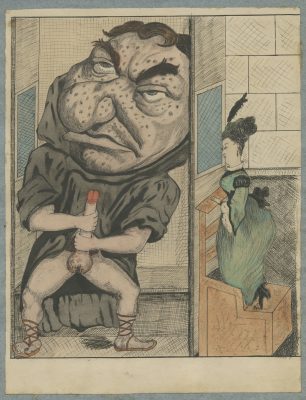 5) Napoléon III et Thérèsa (chanteuse Désirée Emma Valladon): 216 x 176 mm
5) Napoléon III et Thérèsa (chanteuse Désirée Emma Valladon): 216 x 176 mm
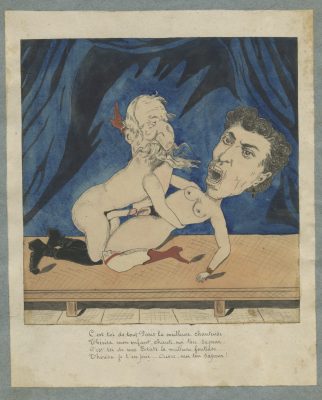
C’est toi de tout Paris la meilleure chanteuse, Thérèsa mon enfant, chante-moi ton sapeur. C’est toi de mes Etats la meilleure fonteuse.. Thérèsa je t’en prie … Ouvre-moi ton sapeur!
You, the best singer in all of Paris, Teresa, my child, sing for me where to insert. You are the best padding in my entire country… Teresa, please... Open your slit for me! 6) Thiers: 219 x 168 mm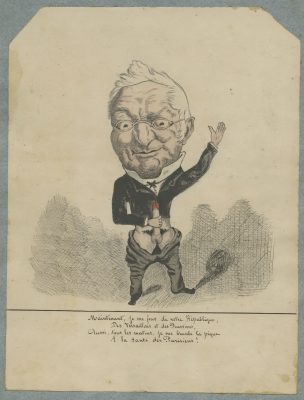
Maintenant, je me fous de votre République, Des Versaillais et des Prussiens, Aussi, tous les matins, je me branle la pique A la santé des Parisiens!
Yes, I don’t care about your Republic now, About Versailles and the Prussians, And every morning I jerk off For the health of Parisians! 7) Émile Ollivier/Rochefort/Jules Favre/Gambetta : 212 x 168 mm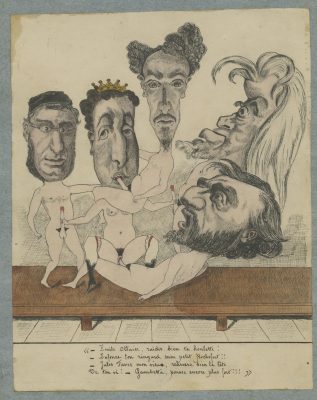
« — Emile Ollivier, raidis bien la houlette! — Enfonce ton ringard mon petit Rochefort!! — Jules Favre mon vieux, redresse bien la tête De ton vi! — Gambetta, pousse encore plus fort!!! »
Emile Ollivier, tighten your dick! - Stick in your poker, my little Rochefort!! - Jules Favre, old man, straighten your dickhead Damn it! – Gambetta, push even harder!!!Characters: Bazaine, François Achille (French, 1811 – 1888) Darboy, Georges (French, 1813 – 1871) Favre, Jules (French, 1809 – 1880) Gambetta, Léon (French, 1838 – 1882) Montijo, Eugénie de (Spanish-French, 1826 – 1920) Napoleon III [Bonaparte, Charles-Louis Napoléon] (French, 1808 – 1873) Ollivier, Émile (French, 1825 – 1913) Peña Azcárate, Josefa [Peña, Pepita] (Mexican-French, 1847 – 1900); Alvarez Rull – nephew of Josefa Peña Azcárate. Rochefort, Henri (French, 1831 – 1913) Thérésa [Valladon, Désirée Emma] (French, 1836 – 1913) Thiers, Adolphe (French, 1797 – 1877)
-
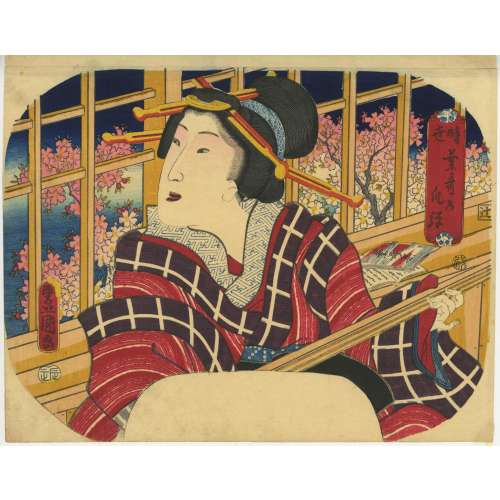 Artist: Utagawa Kunisada [歌川 国貞], a.k.a. Utagawa Toyokuni III [三代 歌川 豊国] (Japanese, 1786 – 1865). Signed: Toyokuni ga [豊国 画] in a red toshidama cartouche Publisher: Iseya Ichiemon [伊勢屋市右衛門] (Japanese, fl. c. 1820s – c. 1860s); seal Tsuji [辻] (Marks 16-029). Media: Untrimmed fan print (uchiwa-e), 225 x 295 mm, plus 10 mm paper strip glued on top (235 mm total height). Title: Plucking Popular Songs in Those Days [時世葉歌の爪弾] (Imayo ha-uta no tsuma-biki). Date seal and aratame seal: Ansei 3 (1856). Seller's Description: Uchiwa-e; picture intended for a summer fan. Here we see a relaxed beauty wearing loose layers of kimono and playing her shamisen instrument. She appears to be in the happy mood of spring, her singing inspired by the cherry blossoms in full bloom that we see outside of her window. She enjoys leisurely plucking with the plectrum of the shamisen and singing “ha-uta” (popular) songs. The title Ha-uta [葉歌] is normally written 端歌, which indicates a certain category of popular songs accompanied by shamisen with short texts that are drawn from daily life. Here however, the title葉歌 uses phonetically the same “ha葉“, referring to the title of the book of a collection of ha-uta songs, Matsu no ha [松の], which was published in five volumes in 1703 by Shûshôken 秀松軒. It is said that this collection of songs was written and sung by the blind (who were often musicians by livelihood). Behind her, lying on the window sill, we see two ha-uta songbooks, one open and one closed. The last half of the title tsuma-biki [爪弾] translates “to pluck with fingers” instead of a plectrum, which is the usual way of playing the shamisen.
Artist: Utagawa Kunisada [歌川 国貞], a.k.a. Utagawa Toyokuni III [三代 歌川 豊国] (Japanese, 1786 – 1865). Signed: Toyokuni ga [豊国 画] in a red toshidama cartouche Publisher: Iseya Ichiemon [伊勢屋市右衛門] (Japanese, fl. c. 1820s – c. 1860s); seal Tsuji [辻] (Marks 16-029). Media: Untrimmed fan print (uchiwa-e), 225 x 295 mm, plus 10 mm paper strip glued on top (235 mm total height). Title: Plucking Popular Songs in Those Days [時世葉歌の爪弾] (Imayo ha-uta no tsuma-biki). Date seal and aratame seal: Ansei 3 (1856). Seller's Description: Uchiwa-e; picture intended for a summer fan. Here we see a relaxed beauty wearing loose layers of kimono and playing her shamisen instrument. She appears to be in the happy mood of spring, her singing inspired by the cherry blossoms in full bloom that we see outside of her window. She enjoys leisurely plucking with the plectrum of the shamisen and singing “ha-uta” (popular) songs. The title Ha-uta [葉歌] is normally written 端歌, which indicates a certain category of popular songs accompanied by shamisen with short texts that are drawn from daily life. Here however, the title葉歌 uses phonetically the same “ha葉“, referring to the title of the book of a collection of ha-uta songs, Matsu no ha [松の], which was published in five volumes in 1703 by Shûshôken 秀松軒. It is said that this collection of songs was written and sung by the blind (who were often musicians by livelihood). Behind her, lying on the window sill, we see two ha-uta songbooks, one open and one closed. The last half of the title tsuma-biki [爪弾] translates “to pluck with fingers” instead of a plectrum, which is the usual way of playing the shamisen. -
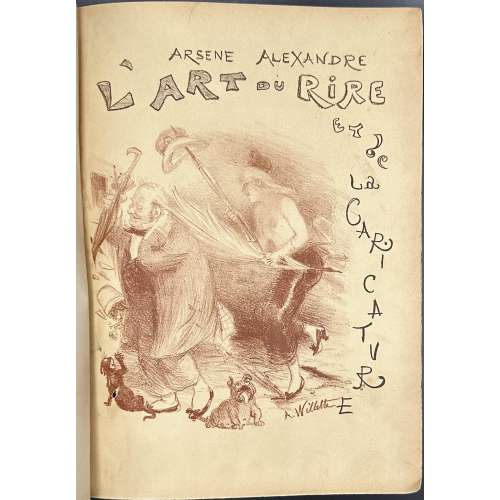 Hardcover volume 28.5 x 20.8 cm, quarter brown morocco over marbled boards, ruled in gilt, spine with raised bands, gilt in compartments, gilt lettering, marbled endpapers, top margin gilt, original lithographic wrappers designed by A. Willette preserved; pp.: [4] h.t., t.p., [1] 2-350 [2], 300 b/w ils in-text and 12 coloured photomechanical reproductions extraneous to collation; collated in-4o: π2 1-444; Title-page: L'ART DU RIRE | ET DE | LA CARICATURE | PAR ARSÈNE ALEXANDRE | 300 FAC-SIMILÉS EN NOIR ET 12 PLANCHES EN COULEURS | D’APRÈS LES ORIGINAUX | {vignette} | PARIS | ANCIENNE MAISON QUANIN | LIBRAIRIES-IMPRIMERIES RÉUNIES | 7, RUE ST-BENOIT | MAY & MOTTEROZ, DIRECTEURS || Contributors : Librairie-Imprimerie réunies (Paris, 1880-1908) – publisher. Arsène Alexandre (French, 1859 – 1937) – author. Adolphe Willette (French, 1857 – 1926) – artist (wrapper)
Hardcover volume 28.5 x 20.8 cm, quarter brown morocco over marbled boards, ruled in gilt, spine with raised bands, gilt in compartments, gilt lettering, marbled endpapers, top margin gilt, original lithographic wrappers designed by A. Willette preserved; pp.: [4] h.t., t.p., [1] 2-350 [2], 300 b/w ils in-text and 12 coloured photomechanical reproductions extraneous to collation; collated in-4o: π2 1-444; Title-page: L'ART DU RIRE | ET DE | LA CARICATURE | PAR ARSÈNE ALEXANDRE | 300 FAC-SIMILÉS EN NOIR ET 12 PLANCHES EN COULEURS | D’APRÈS LES ORIGINAUX | {vignette} | PARIS | ANCIENNE MAISON QUANIN | LIBRAIRIES-IMPRIMERIES RÉUNIES | 7, RUE ST-BENOIT | MAY & MOTTEROZ, DIRECTEURS || Contributors : Librairie-Imprimerie réunies (Paris, 1880-1908) – publisher. Arsène Alexandre (French, 1859 – 1937) – author. Adolphe Willette (French, 1857 – 1926) – artist (wrapper) -
![[Hippolyte Prosper Olivier LISSAGARAY]. History of the Commune of 1871 / Translated from the French of Lissagaray by Eleanor Marx Aveling. London: Reeved and Turner, 1886. pp.: [i-v] vi-xv [1] 2-500.](https://varshavskycollection.com/wp-content/uploads/2021/02/LIB-1110.2016-d-500x500.jpeg) Hardcover volume, collated in-8o, 21.9 c 14.6 cm, bound in half red morocco over red buckram by Palmer, Hove & Co. (Manchester), ruled in gilt, marbled end-papers, top edge gilt, spine with raised bands, ruled in gilt, gilt lettering; bookplate "Ex libris William John Robertson" with black ink ms dated 1922 to front pastedown. Insert paper clipping “In Memoriam” marked “D.W. 25.1.61.” Graphite ms to t.p.: “[assisted by Karl Marx]”. Pp.: [i-v] vi-xv [xvi blank], [1] 2-500; collation: ffl blank first and last, π8 A-2H8 2I2. Title-page: HISTORY | OF | THE COMMUNE OF 1871. | Translated from the French of | LISSAGARAY, | BY | ELEANOR MARX AVELING. | LONDON: | REEVES AND TURNER, 196 STRAND. | 1886.|| Contributors: Hippolyte Prosper-Olivier Lissagaray (French, 1838 – 1901) – author. Eleanor Marx [Aveling] (British, 1855 – 1898) – translator. William John Robertson (Canadian, 1846 – 1894) – provenance. The Russian translation of the same title: [LIB-1158.2016] Э. Лиссагарэ. История Парижской Коммуны в 1871 г. (Дешевая библиотека, № 274) / Пер. под ред. В. Базарова. — С.-Петербург: Знание, 1906.
Hardcover volume, collated in-8o, 21.9 c 14.6 cm, bound in half red morocco over red buckram by Palmer, Hove & Co. (Manchester), ruled in gilt, marbled end-papers, top edge gilt, spine with raised bands, ruled in gilt, gilt lettering; bookplate "Ex libris William John Robertson" with black ink ms dated 1922 to front pastedown. Insert paper clipping “In Memoriam” marked “D.W. 25.1.61.” Graphite ms to t.p.: “[assisted by Karl Marx]”. Pp.: [i-v] vi-xv [xvi blank], [1] 2-500; collation: ffl blank first and last, π8 A-2H8 2I2. Title-page: HISTORY | OF | THE COMMUNE OF 1871. | Translated from the French of | LISSAGARAY, | BY | ELEANOR MARX AVELING. | LONDON: | REEVES AND TURNER, 196 STRAND. | 1886.|| Contributors: Hippolyte Prosper-Olivier Lissagaray (French, 1838 – 1901) – author. Eleanor Marx [Aveling] (British, 1855 – 1898) – translator. William John Robertson (Canadian, 1846 – 1894) – provenance. The Russian translation of the same title: [LIB-1158.2016] Э. Лиссагарэ. История Парижской Коммуны в 1871 г. (Дешевая библиотека, № 274) / Пер. под ред. В. Базарова. — С.-Петербург: Знание, 1906. -
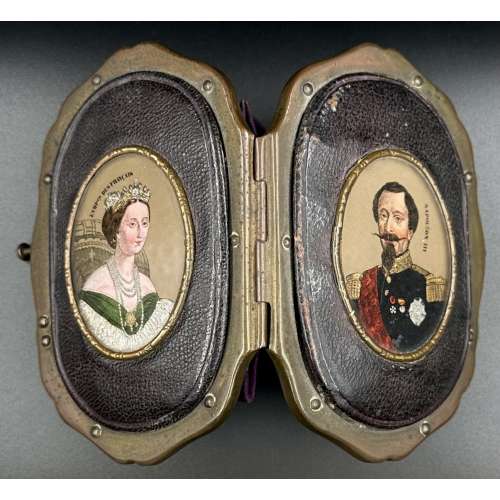 Coin purse, or porte-monnaie, made of patinated copper alloy, full-grain brown leather outside and purple inside, with a clutch and a hinge, and an oval miniature bust portrait on each side, painted in colour with gold and silver, by an anonymous artist after Franz Xaver Winterhalter, inscribed NAPOLÉON III and L'IMPCE DES FRANÇAIS, respectively, under glass. Dimensions: 97 x 67 x 18 mm. Contributors: Napoleon III [Charles Louis Napoléon Bonaparte] (French, 1808 – 1873) – character/sitter. Eugénie de Montijo [María Eugenia Ignacia Agustina de Palafox y Kirkpatrick] (Spanish-French, 1826 – 1920) – character/sitter. Franz Xaver Winterhalter (German, 1805 – 1873) – artist.
Coin purse, or porte-monnaie, made of patinated copper alloy, full-grain brown leather outside and purple inside, with a clutch and a hinge, and an oval miniature bust portrait on each side, painted in colour with gold and silver, by an anonymous artist after Franz Xaver Winterhalter, inscribed NAPOLÉON III and L'IMPCE DES FRANÇAIS, respectively, under glass. Dimensions: 97 x 67 x 18 mm. Contributors: Napoleon III [Charles Louis Napoléon Bonaparte] (French, 1808 – 1873) – character/sitter. Eugénie de Montijo [María Eugenia Ignacia Agustina de Palafox y Kirkpatrick] (Spanish-French, 1826 – 1920) – character/sitter. Franz Xaver Winterhalter (German, 1805 – 1873) – artist.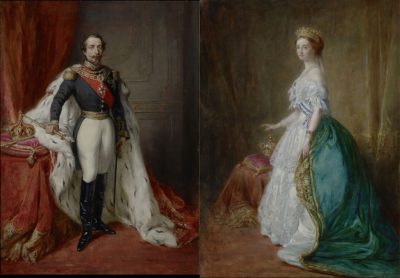
-
 Artist: Utagawa Kunisada [歌川 国貞], a.k.a. Utagawa Toyokuni III [三代 歌川 豊国] (Japanese, 1786 – 1865). Signed: Toyokuni ga [豊国 画] in a red toshidama cartouche Block carver: Yokokawa Takejirō [横川竹二郎] (Japanese, fl. 1845 – 1863), seal: 彫竹 – hori Take. Publisher: Ibaya Senzaburō [伊場屋仙三郎] (Japanese, fl. c. 1845 – 1847). Media: Untrimmed fan print (uchiwa-e), 238 x 304 mm. Title: Saiko (West River) [西江]; 西江 means the Xi River in China. Series: Chronicles of Elegant Women [風雅女史傳] (Fūga joshiden). Combined date seal and kiwame censor seal: Ansei 6 (1859). Other prints from the same series in this collection: SVJP-0216.2016 — Princess Sotoori:
Artist: Utagawa Kunisada [歌川 国貞], a.k.a. Utagawa Toyokuni III [三代 歌川 豊国] (Japanese, 1786 – 1865). Signed: Toyokuni ga [豊国 画] in a red toshidama cartouche Block carver: Yokokawa Takejirō [横川竹二郎] (Japanese, fl. 1845 – 1863), seal: 彫竹 – hori Take. Publisher: Ibaya Senzaburō [伊場屋仙三郎] (Japanese, fl. c. 1845 – 1847). Media: Untrimmed fan print (uchiwa-e), 238 x 304 mm. Title: Saiko (West River) [西江]; 西江 means the Xi River in China. Series: Chronicles of Elegant Women [風雅女史傳] (Fūga joshiden). Combined date seal and kiwame censor seal: Ansei 6 (1859). Other prints from the same series in this collection: SVJP-0216.2016 — Princess Sotoori:

-
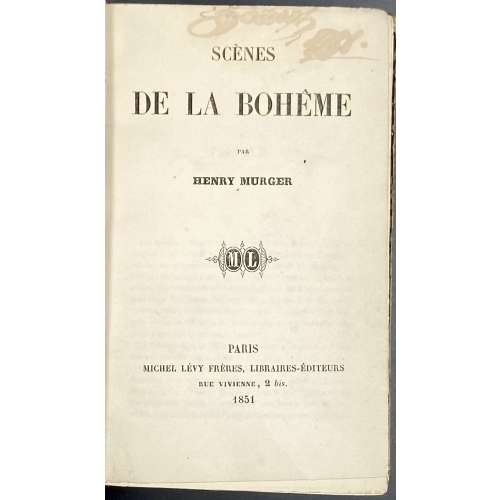 Hardcover volume, 18.2 x 11.8 cm, bound in quarter black polished calf with gilt lettering “cartonnage romantique” design to spine, marbled boards, matching marbled endpapers, blue margins. Title-page: SCÈNES | DE LA BOHÊME | PAR | HENRY MURGER | {publisher’s device ML} | PARIS | MICHEL LÉVY FRÈRES, LIBRAIRES-ÉDITEURS | RUE VIVIENNE, 2 bis. | 1851 || Half-title: ŒUVRES | D’HENRY MURGER || Advertisement: Chez le même Éditeurs. | BIBLIOTHEQUE CONTEMPORAINE | (page of text) || Collation: π2 (h.t/advert., t.p. / blank), 1-33 (17)12, χ6; total 212 leaves without ffls (3 front, 2 back). Pagination: [2] – h.t. / blank, [2] – t.p. / blank, [i] ii-xiii [xiv blank], [1] 2-406; total 424 pages. Scènes de la bohême, in later editions Scènes de la vie de bohème. Translations: Into English: LIB-2719.2021. Henri Murger. The Bohemians of the Latin Quarter. (Scènes de la vie de Bohême) / Translated from the French. — London: Vizetelly & Co., 1883. Into German: LIB-2686.2021. Henri Murger. Die Bohème : Szenen aus dem Pariser Künstlerleben. — Leipzig: Insel-Verlag, 1906. Into Russian: LIB-3182.2023. А. Мюрже. Сцены из жизни богемы / Пер. с франц. и прим. Е. А. Гунста; вст. ст. С. И. Великовского; художник Н. А. Кравченко. — М.: Художественная литература, 1963. Contributors: Murger, Henri [Henry] (French, 1822 – 1861) – author.
Hardcover volume, 18.2 x 11.8 cm, bound in quarter black polished calf with gilt lettering “cartonnage romantique” design to spine, marbled boards, matching marbled endpapers, blue margins. Title-page: SCÈNES | DE LA BOHÊME | PAR | HENRY MURGER | {publisher’s device ML} | PARIS | MICHEL LÉVY FRÈRES, LIBRAIRES-ÉDITEURS | RUE VIVIENNE, 2 bis. | 1851 || Half-title: ŒUVRES | D’HENRY MURGER || Advertisement: Chez le même Éditeurs. | BIBLIOTHEQUE CONTEMPORAINE | (page of text) || Collation: π2 (h.t/advert., t.p. / blank), 1-33 (17)12, χ6; total 212 leaves without ffls (3 front, 2 back). Pagination: [2] – h.t. / blank, [2] – t.p. / blank, [i] ii-xiii [xiv blank], [1] 2-406; total 424 pages. Scènes de la bohême, in later editions Scènes de la vie de bohème. Translations: Into English: LIB-2719.2021. Henri Murger. The Bohemians of the Latin Quarter. (Scènes de la vie de Bohême) / Translated from the French. — London: Vizetelly & Co., 1883. Into German: LIB-2686.2021. Henri Murger. Die Bohème : Szenen aus dem Pariser Künstlerleben. — Leipzig: Insel-Verlag, 1906. Into Russian: LIB-3182.2023. А. Мюрже. Сцены из жизни богемы / Пер. с франц. и прим. Е. А. Гунста; вст. ст. С. И. Великовского; художник Н. А. Кравченко. — М.: Художественная литература, 1963. Contributors: Murger, Henri [Henry] (French, 1822 – 1861) – author. -
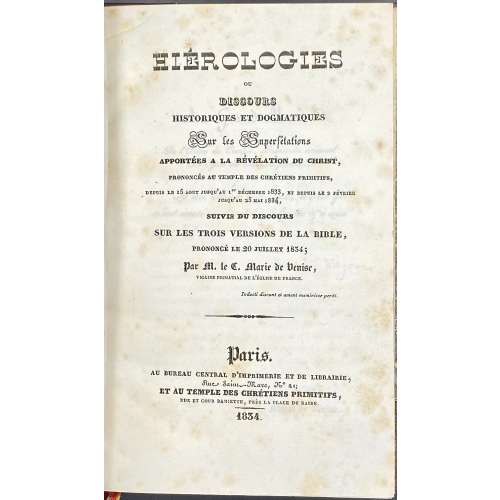 Hardcover volume, 20.7 x 13.5 cm, modern half morocco over marbled boards, gilt lettering and ornament to spine, pp.: [i-vii] viii-xvi [17] 18-255 [256], collated 8vo: 1-168, 128 leaves. Title-page: HIÉROLOGIES | OU | DISCOURS | HISTORIQUES ET DOGMATIQUES | Sur les Superfétations | APPORTÉES A LA RÉVÉLATION DU CHRIST, | PRONONCÉS AU TEMPLE DES CHRÉTIENS PRIMITIFS, | DEPUIS LE 15 AOUT JUSQU’AU 1er DÉCEMBRE 1833, ET DEPUIS LE 2 FÉVRIER | JUSQU’AU 25 MAI 1834, | SUIVIS DU DISCOURS | SUR LES TROIS VERSIONS DE LA BIBLE, | PRONONCÉ LE 20 JUILLET 1834 ; | Par M. le C. Marie de Venise, | VICAIRE PRIMATIAL DE L’EGLISE DE France. | {1 line citation} | — | Paris. | AU BUREAU CENTRAL D’IMPRIMERIE ET DE LIBRAIRE, | Rue Saint-Marc, No 21; | ET AU TEMPLE DES CHRÉTIENS PRIMITIFS, | RUE ET COUR DAMIETTE, PRÈS LA PLACE DU KAIRE. | — | 1834 || Contributors : Félix Ragon (French, 1795 – 1872) – author. Seller's description: [RAGON (Félix) : Hiérologies ou Discours historiques et dogmatiques sur les Superfétations apportées à la révélation du Christ suivis du Discours sur les trois versions de la Bible. Paris, au Bureau central et au Temple des Chrétiens Primitifs, 1834 ; in 8°, demi-basane brune à coins. Reliure pastiche moderne. Edition originale extrêmement rare, dont le tirage est estimé à 50 ex.
Hardcover volume, 20.7 x 13.5 cm, modern half morocco over marbled boards, gilt lettering and ornament to spine, pp.: [i-vii] viii-xvi [17] 18-255 [256], collated 8vo: 1-168, 128 leaves. Title-page: HIÉROLOGIES | OU | DISCOURS | HISTORIQUES ET DOGMATIQUES | Sur les Superfétations | APPORTÉES A LA RÉVÉLATION DU CHRIST, | PRONONCÉS AU TEMPLE DES CHRÉTIENS PRIMITIFS, | DEPUIS LE 15 AOUT JUSQU’AU 1er DÉCEMBRE 1833, ET DEPUIS LE 2 FÉVRIER | JUSQU’AU 25 MAI 1834, | SUIVIS DU DISCOURS | SUR LES TROIS VERSIONS DE LA BIBLE, | PRONONCÉ LE 20 JUILLET 1834 ; | Par M. le C. Marie de Venise, | VICAIRE PRIMATIAL DE L’EGLISE DE France. | {1 line citation} | — | Paris. | AU BUREAU CENTRAL D’IMPRIMERIE ET DE LIBRAIRE, | Rue Saint-Marc, No 21; | ET AU TEMPLE DES CHRÉTIENS PRIMITIFS, | RUE ET COUR DAMIETTE, PRÈS LA PLACE DU KAIRE. | — | 1834 || Contributors : Félix Ragon (French, 1795 – 1872) – author. Seller's description: [RAGON (Félix) : Hiérologies ou Discours historiques et dogmatiques sur les Superfétations apportées à la révélation du Christ suivis du Discours sur les trois versions de la Bible. Paris, au Bureau central et au Temple des Chrétiens Primitifs, 1834 ; in 8°, demi-basane brune à coins. Reliure pastiche moderne. Edition originale extrêmement rare, dont le tirage est estimé à 50 ex. -
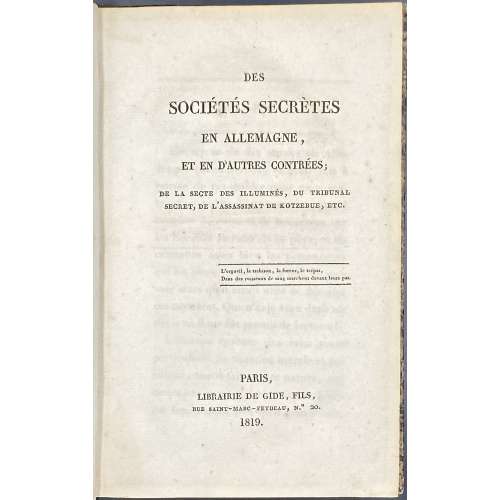 Hardcover volume, 20.4 x 13.1 cm, quarter contemporary calf over modern brown marbled board, printed on laid paper, pp.: [i-v] vi-xii, [13] 14-259 [260] blank; collated 8vo: 1-168 172; total 130 leaves. Title-page: DES | SOCIÉTÉS SECRÈTES | EN ALLEMAGNE, | ET EN D'AUTRES CONTREES; | DE LA SECTE DES ILLUMINÉS DU TRIBUNAL | SECRET, DE L'ASSASSINAT DE KOTZEBUE, ETC. | {two lines in rules} | PARIS, | LIBRAIRIE DE GIDE, FILS, | RUE SAINT–MARC–FEYDEAU, No. 20. | 1819. || Contributors: Vincent Lombard de Langres (French, 1765 – 1830) – author. Théophile-Étienne Gide (French, 1767 – 1837) – publisher. Seller's description: [LOMBARD DE LANGRES (Vincent)]. Des Sociétés secrètes en Allemagne, et en d'autres contrées. Paris, Gide fils, 1819 ; in 8°, demi basane fauve, dos lisse orné. Reliure de l'époque. Edition originale rare. L'auteur, révolutionnaire, fut ami de Danton et de Barras. Dans son ouvrage anti maçonnique, il dévoile les doctrines des sociétés secrètes, leurs principes, leur influence dans la société. Caillet 6770.
Hardcover volume, 20.4 x 13.1 cm, quarter contemporary calf over modern brown marbled board, printed on laid paper, pp.: [i-v] vi-xii, [13] 14-259 [260] blank; collated 8vo: 1-168 172; total 130 leaves. Title-page: DES | SOCIÉTÉS SECRÈTES | EN ALLEMAGNE, | ET EN D'AUTRES CONTREES; | DE LA SECTE DES ILLUMINÉS DU TRIBUNAL | SECRET, DE L'ASSASSINAT DE KOTZEBUE, ETC. | {two lines in rules} | PARIS, | LIBRAIRIE DE GIDE, FILS, | RUE SAINT–MARC–FEYDEAU, No. 20. | 1819. || Contributors: Vincent Lombard de Langres (French, 1765 – 1830) – author. Théophile-Étienne Gide (French, 1767 – 1837) – publisher. Seller's description: [LOMBARD DE LANGRES (Vincent)]. Des Sociétés secrètes en Allemagne, et en d'autres contrées. Paris, Gide fils, 1819 ; in 8°, demi basane fauve, dos lisse orné. Reliure de l'époque. Edition originale rare. L'auteur, révolutionnaire, fut ami de Danton et de Barras. Dans son ouvrage anti maçonnique, il dévoile les doctrines des sociétés secrètes, leurs principes, leur influence dans la société. Caillet 6770. -
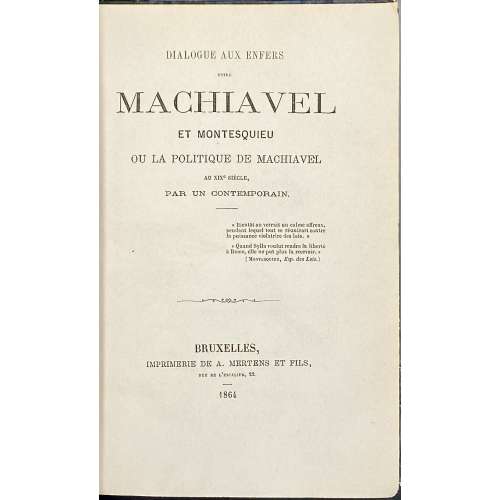 Title page: DIALOGUE AUX ENFERS | ENTRE | MACHIAVEL | ET MONTESQUIEU | OU LA POLITIQUE DE MACHIAVEL | AU XIXe SIÈCLE, | PAR UN CONTEMPORAIN. | {6 lines of citations} | ~ | BRUXELLES, | IMPRIMERIE DE A. MERTENS ET FILS, | RUE DE L’ESCALIER, 22. | – | 1864 || Description: 19 x 12.7 cm, quarter green morocco over blue marbled boards, spine with raised bands ruled in gilt, gilt fleurons in compartments, gilt lettering, marbled endpapers; three paper clippings laid in. Collation: 12mo; π5 1-2712 292; total 175 leaves. Pagination: [2] blank, [2] h.t, [2] t.p. [i] ii-iii [iv] [1] 2-337 [338] blank [2] errata]; total 350 pages. Contributors: Maurice Joly (French, 1829 – 1878) – author. Characters: Niccolò Machiavelli (Italian, 1469 – 1527) Charles Louis de Secondat, baron de La Brède et de Montesquieu (French, 1689 – 1755) The publication was funded by the author and smuggled into France. See other copies: LIB-2913.2021, LIB-1034.2016 and LIB-0460.2015. Other related objects: SVVP-0062.2021. Seller's description: [JOLY (Maurice)]: Dialogue aux enfers entre Machiavel et Montesquieu. Bruxelles, Mertens et fils, 1864 ; un volume in 12, demi-chagrin vert orné de l'époque. C'est dans ce livre que Joly écrit, au prétexte d'une discussion philosophique et politique, comment Napoléon III, selon lui, a manipulé les milieux économiques, la presse, l'opinion publique, les syndicats, les milieux ouvriers, le peuple, etc., pour établir un pouvoir politique fort, ce qui lui valut un séjour de 15 mois à la prison Sainte-Pélagie à Paris.
Title page: DIALOGUE AUX ENFERS | ENTRE | MACHIAVEL | ET MONTESQUIEU | OU LA POLITIQUE DE MACHIAVEL | AU XIXe SIÈCLE, | PAR UN CONTEMPORAIN. | {6 lines of citations} | ~ | BRUXELLES, | IMPRIMERIE DE A. MERTENS ET FILS, | RUE DE L’ESCALIER, 22. | – | 1864 || Description: 19 x 12.7 cm, quarter green morocco over blue marbled boards, spine with raised bands ruled in gilt, gilt fleurons in compartments, gilt lettering, marbled endpapers; three paper clippings laid in. Collation: 12mo; π5 1-2712 292; total 175 leaves. Pagination: [2] blank, [2] h.t, [2] t.p. [i] ii-iii [iv] [1] 2-337 [338] blank [2] errata]; total 350 pages. Contributors: Maurice Joly (French, 1829 – 1878) – author. Characters: Niccolò Machiavelli (Italian, 1469 – 1527) Charles Louis de Secondat, baron de La Brède et de Montesquieu (French, 1689 – 1755) The publication was funded by the author and smuggled into France. See other copies: LIB-2913.2021, LIB-1034.2016 and LIB-0460.2015. Other related objects: SVVP-0062.2021. Seller's description: [JOLY (Maurice)]: Dialogue aux enfers entre Machiavel et Montesquieu. Bruxelles, Mertens et fils, 1864 ; un volume in 12, demi-chagrin vert orné de l'époque. C'est dans ce livre que Joly écrit, au prétexte d'une discussion philosophique et politique, comment Napoléon III, selon lui, a manipulé les milieux économiques, la presse, l'opinion publique, les syndicats, les milieux ouvriers, le peuple, etc., pour établir un pouvoir politique fort, ce qui lui valut un séjour de 15 mois à la prison Sainte-Pélagie à Paris. -
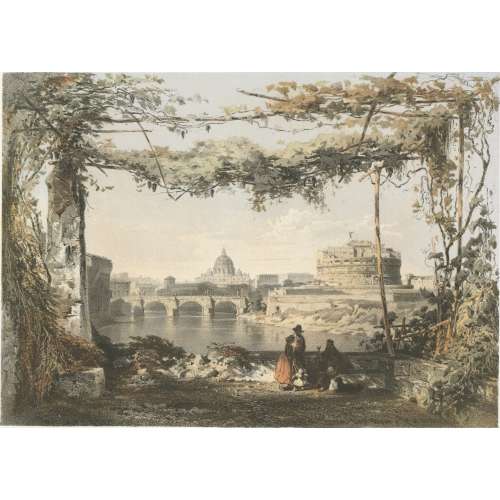
Sheet № 20 from the series of 42 сhromolithography prints 'Skizzen und Bilder aus ROM und der Umgegend' (Sketches and pictures from Rome and surroundings).
Inscriptions:
Top left: LINDEMANN-FROMMEL’S Top right: Skizzen und Bilder aus ROM und der Umgegend. Centre below: No 20 | IL CASTEL E IL PONTE SANT ANGELO, | E SAN PIETRO. Bottom left: Imp. de JACOMME et Cie. R. de Lancry, 16 Paris. Bottom centre: Stuttgart, bei FRANZ KÖHLER. Bottom right: Paris, Goupil et Cie. Editeurs.Dimensions:
Plate: 372 x 473 mm Sheet: 372 x 473 mm
Contributors:
Lindemann-Frommel, Karl (French-German, 1819 – 1891) – artist. Jacomme, Claude (French, fl. 1838 – 1857) – printer/lithographer. Goupil et Cie (Paris); Goupil, Adophe (French, 1806 – 1893) – publisher Franz Köhler (Stuttgart); Köhler, Franz (German, 1805 – 1872) – publisher. -
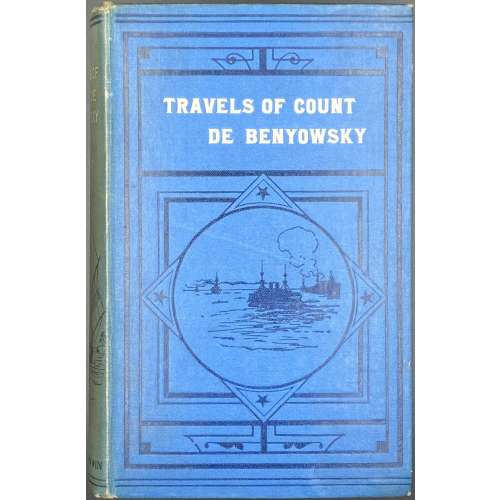 Hardcover volume in 8vo, 20.4 x 13.7 cm, blue cloth with black pictorial stamping and white embossed lettering to front cover and spine, spine sunned, head and tail frayed. Title-page: ❦❦❦ THE MEMOIRS AND | TRAVELS OF MAURITIUS | AUGUSTUS COUNT DE | BENYOWSKY ❦❦❦ | IN SIBERIA, KAMCHATKA, JAPAN, | THE LIUKIU ISLANDS AND FORMOSA | FROM THE TRANSLATION OF HIS | ORIGINAL MANUSCRIPT (1741–1771), | BY WILLIAM NICHOLSON, F.R.S., 1790 | EDITED BY CAPTAIN | PASFIELD OLIVER | ILLUSTRATED | LONDON: T. FISHER UNWIN, | PATERNOSTER SQUARE. MDCCCXCVIII || Collation/Pagination: [1]7 2-258; blue advertisement sheet laid in. [1, 2] – serial h.t. "The Adventure Series" / advert. THE ADVENTURE SERIES. Illustrated. Popular Re-issue, large cr. 8vo, 3s. 6d. 8 titles, [3, 4] – t.p. / blank, [5] 6-9 contents, [10] blank, [11, 12] missing, [13] 14-52 introduction, 53-399, [400] colophon: THE GRESHAM PRESS, | URWIN BROTHERS, | WORKING IN LONDON. Total number of leaves 199; 398 pages; one leaf of the first gathering missing (pp. 11/12 list of illustrations. No illustrations in this volume. Compared to another copy of the same edition, LIB-2701.2021, besides the binding: no list of illustrations, no illustrations, different colophon, different advertisement, slightly different h.t. Contributors: Publisher: T. Fisher Unwin (London); Thomas Fisher Unwin (British, 1848 – 1935). Author: Maurice Auguste count de Benyowsky [Мориц Август Бенёвский] (Polish-Slovak-Hungarian, 1746 –1786). Editor: Samuel Pasfield Oliver (British, 1838 – 1907). Translator: William Nicholson (British, 1753 – 1815). Originally published in 1790, in London (I have not seen it anywhere) and in Dublin by P. Wogan [etc.], and in 1791 in French, in Paris by Buisson; see LIB-2742.2021. For the 1904 edition, see LIB-2703.2021.
Hardcover volume in 8vo, 20.4 x 13.7 cm, blue cloth with black pictorial stamping and white embossed lettering to front cover and spine, spine sunned, head and tail frayed. Title-page: ❦❦❦ THE MEMOIRS AND | TRAVELS OF MAURITIUS | AUGUSTUS COUNT DE | BENYOWSKY ❦❦❦ | IN SIBERIA, KAMCHATKA, JAPAN, | THE LIUKIU ISLANDS AND FORMOSA | FROM THE TRANSLATION OF HIS | ORIGINAL MANUSCRIPT (1741–1771), | BY WILLIAM NICHOLSON, F.R.S., 1790 | EDITED BY CAPTAIN | PASFIELD OLIVER | ILLUSTRATED | LONDON: T. FISHER UNWIN, | PATERNOSTER SQUARE. MDCCCXCVIII || Collation/Pagination: [1]7 2-258; blue advertisement sheet laid in. [1, 2] – serial h.t. "The Adventure Series" / advert. THE ADVENTURE SERIES. Illustrated. Popular Re-issue, large cr. 8vo, 3s. 6d. 8 titles, [3, 4] – t.p. / blank, [5] 6-9 contents, [10] blank, [11, 12] missing, [13] 14-52 introduction, 53-399, [400] colophon: THE GRESHAM PRESS, | URWIN BROTHERS, | WORKING IN LONDON. Total number of leaves 199; 398 pages; one leaf of the first gathering missing (pp. 11/12 list of illustrations. No illustrations in this volume. Compared to another copy of the same edition, LIB-2701.2021, besides the binding: no list of illustrations, no illustrations, different colophon, different advertisement, slightly different h.t. Contributors: Publisher: T. Fisher Unwin (London); Thomas Fisher Unwin (British, 1848 – 1935). Author: Maurice Auguste count de Benyowsky [Мориц Август Бенёвский] (Polish-Slovak-Hungarian, 1746 –1786). Editor: Samuel Pasfield Oliver (British, 1838 – 1907). Translator: William Nicholson (British, 1753 – 1815). Originally published in 1790, in London (I have not seen it anywhere) and in Dublin by P. Wogan [etc.], and in 1791 in French, in Paris by Buisson; see LIB-2742.2021. For the 1904 edition, see LIB-2703.2021. -
 Artist: Utagawa Kuniyoshi [歌川 國芳] (1798 – 1861). A beauty leaning on a fence and watching a dragonfly hovering above a flowering plant. Signed: Ichiyûsai Kuniyoshi ga (一勇斎 國芳 画) in a double gourd-shaped red cartouche. Publisher: Maruya Jinpachi, seal Jin [甚] (Marks 08-088 | 294d). No date/censor seal. Media: Fan print (uchiwa-e, 団扇絵), 234 x 301 mm.
Artist: Utagawa Kuniyoshi [歌川 國芳] (1798 – 1861). A beauty leaning on a fence and watching a dragonfly hovering above a flowering plant. Signed: Ichiyûsai Kuniyoshi ga (一勇斎 國芳 画) in a double gourd-shaped red cartouche. Publisher: Maruya Jinpachi, seal Jin [甚] (Marks 08-088 | 294d). No date/censor seal. Media: Fan print (uchiwa-e, 団扇絵), 234 x 301 mm. -
 Artist: Utagawa Kuniyoshi [歌川 國芳] (1798 – 1861). Kabuki actors Ichikawa Danjūrō VIII and Arashi Rikan III as sumo wrestlers Nuregami Chōgorō (L) and Hanaregoma Chōkichi (R), respectively. Signed: Ichiyûsai Kuniyoshi ga (一勇斎 國芳 画) in a double gourd-shaped cartouche with Yoshi Kiri seal. Publisher: No seal. Date seal and double nanushi censor seal: Mera & Watanabe, 1852. Media: Fan print (uchiwa-e, 団扇絵), 231 x 295 mm. Theme: Nine-act drama (11 scenes) Futatsu Chōchō Kuruwa Nikki [双蝶々曲輪日記] (A Diary of Two Butterflies in the Pleasure Quarters) written by Takeda Izumo II, Namiki Senryū I, Miyoshi Shōraku (7/1749) as puppet play Bunraku [文楽], adopted for Kabuki theatre by Arashi San'emon IV. “The sumo wrestler Nuregami Chōgorō is trying to ransom the courtesan Azuma for Yogoro, in whose debt he stands. Hiraoka Goemon, who is at odds with Yogorō and Azuma, is the patron of the amateur wrestler Hanaregoma Chōkichi. Chōgorō purposely loses to Chōkichi and then asks the latter to stop Goemon's ransoming of Azuma; Chōkichi refuses, however, and they quarrel. Admonished for his dissipation by his sister Oseki, Chōkichi is going to commit ritual suicide (seppuku) as an apology for his behavior, but Chōgorō, who happens along just then, prevents him. The two men swear blood brotherhood. […] The confrontation between Chōgorō and Chōkichi in the Sumōba scene, acted in the exaggerated style called aragoto, is a major highlight of the work. The scene in Yohei's home, known as Hikimado, presents the unfolding of Kabuki's eternal conflict between duty and feelings, here represented by the act of opening the skylight (hikimado) to which Chōgorō is tied”. [Samuel L. Leiter. Kabuki Encyclopedia: an English-language adaptation of Kabuki Jiten. — Westport, CT; London: Greenwood Press, 1979, pp. 70-71]. See also James R. Brandon and Samuel L. Leiter. Kabuki plays on stage, vol. 1, pp. 234-258. — Honolulu: University of Hawai'i Press, 2002. Actors: Ichikawa Danjūrō VIII [市川団十郎] (Japanese, 1823 – 1854); other names: Ichikawa Ebizō VI, Ichikawa Shinnosuke II. Arashi Rikan III [嵐璃寛] (Japanese, 1812 – 1863); other names Arashi Tokusaburō III, Arashi Kicchō I, Onoe Wasaburō I. Another print in this collection with the same theme: SVJP-0331.2020.
Artist: Utagawa Kuniyoshi [歌川 國芳] (1798 – 1861). Kabuki actors Ichikawa Danjūrō VIII and Arashi Rikan III as sumo wrestlers Nuregami Chōgorō (L) and Hanaregoma Chōkichi (R), respectively. Signed: Ichiyûsai Kuniyoshi ga (一勇斎 國芳 画) in a double gourd-shaped cartouche with Yoshi Kiri seal. Publisher: No seal. Date seal and double nanushi censor seal: Mera & Watanabe, 1852. Media: Fan print (uchiwa-e, 団扇絵), 231 x 295 mm. Theme: Nine-act drama (11 scenes) Futatsu Chōchō Kuruwa Nikki [双蝶々曲輪日記] (A Diary of Two Butterflies in the Pleasure Quarters) written by Takeda Izumo II, Namiki Senryū I, Miyoshi Shōraku (7/1749) as puppet play Bunraku [文楽], adopted for Kabuki theatre by Arashi San'emon IV. “The sumo wrestler Nuregami Chōgorō is trying to ransom the courtesan Azuma for Yogoro, in whose debt he stands. Hiraoka Goemon, who is at odds with Yogorō and Azuma, is the patron of the amateur wrestler Hanaregoma Chōkichi. Chōgorō purposely loses to Chōkichi and then asks the latter to stop Goemon's ransoming of Azuma; Chōkichi refuses, however, and they quarrel. Admonished for his dissipation by his sister Oseki, Chōkichi is going to commit ritual suicide (seppuku) as an apology for his behavior, but Chōgorō, who happens along just then, prevents him. The two men swear blood brotherhood. […] The confrontation between Chōgorō and Chōkichi in the Sumōba scene, acted in the exaggerated style called aragoto, is a major highlight of the work. The scene in Yohei's home, known as Hikimado, presents the unfolding of Kabuki's eternal conflict between duty and feelings, here represented by the act of opening the skylight (hikimado) to which Chōgorō is tied”. [Samuel L. Leiter. Kabuki Encyclopedia: an English-language adaptation of Kabuki Jiten. — Westport, CT; London: Greenwood Press, 1979, pp. 70-71]. See also James R. Brandon and Samuel L. Leiter. Kabuki plays on stage, vol. 1, pp. 234-258. — Honolulu: University of Hawai'i Press, 2002. Actors: Ichikawa Danjūrō VIII [市川団十郎] (Japanese, 1823 – 1854); other names: Ichikawa Ebizō VI, Ichikawa Shinnosuke II. Arashi Rikan III [嵐璃寛] (Japanese, 1812 – 1863); other names Arashi Tokusaburō III, Arashi Kicchō I, Onoe Wasaburō I. Another print in this collection with the same theme: SVJP-0331.2020. Reference images:
Reference images:
-
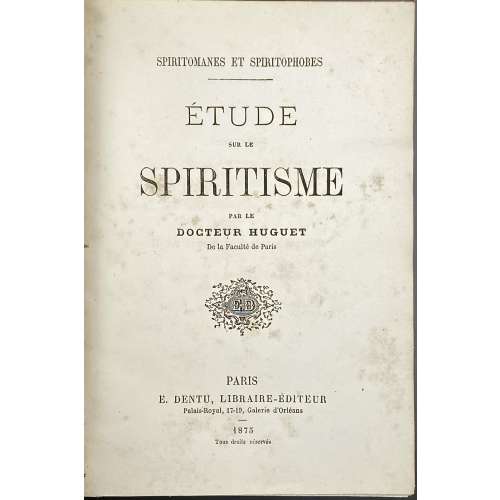 Hardcover volume 20 x 14 cm, bound in burgundy half faux chagrin over brown faux chagrin boards, gilt lettering to spine, marbled endpapers, all margins sprinkled blue. Convolute: 1) SPIRITOMANES ET SPIRITOPHOBES |— | ÉTUDE | SUR LE | SPIRITISME | PAR LE | DOCTEUR HUGUET | De la Faculté de Paris | {« ED » publsiher’s device} | PARIS | E. DENTU, LIBRAIRE-ÉDUTEUR | Palais-Royal, 17-19, Galerie d’Orléans | – | 1875 | Tous droits réservés ||; pp. [1-7] 8-48, with Dr Huguet signature to h.t. verso. Contents: Introduction. I. Le procès du 16 juin 1875; MM. Firman, Buguet, Leymarie. II. Le Spiritisme dans ses rapports avec le dogme, l’histoire, la science. Conclusion. 2) Same, pp. [1-7] 8-48, with Dr Huguet signature to h.t. verso. 3) FÉDÉRATION SPIRITE BELGE | — | Étude critique | DU LIVRE INTITULÉ | L'Hypnotisme | et le Spiritisme | du Docteur Joseph LAPPONI | Médecin de L. L. S. S. LÉON XIII et PIE X. | * | CONFÉRENCE | PAR | J. FRAIKIN | Président de la Fédération Spirite de Liége, | Vice-Président de la Fédération Spirite Belge. | * | Imp. Emile Dumon | Rue Haute-Marexhe, 27, Herstal-Liége. ||; pp. [1-3] 4-50 [51] errata/blank. 4) BUREAU PERMANENT D’ÉTUDE | DES | PHÉNOMÈNES SPIRITES | ANVERS | * | Cours De Doctrine Spirite | — | Imprimerie et Publicité « LA GÉNÉRALE » (SOC. AN.) Anvers. ||; 6 leaves, pagination trimmed out with partly visible numbers 13 and 18 ; includes Deuxième leçon « Du passage de la vie… », t.p., 7 pp. of text, last three pages blank. 5) LA PSYCHOLOGIE EXPERIMENTALE || Manifeste adresse par le « Syndicat de la Presse spiritualiste de France » | au Congres spiritualiste de Londres (Juin 1898); pp. [1] 2-31 [32]. Contents: I. Prolégomènes. II. Télépathie. III. Médiumnité. Conclusion. 6) LE FLUIDE HUMAIN | Son existence/ | Ses lois * Ses propriétés | — | CONFÉRENCE | DONNÉE PAR LE | Sous-Lieutenant DE BACKERE | — ||; pp. [1-3] 4-28. Contributors: Hilarion Huguet (French, ? – ?) Alfred-Henri Firman (American, ? – ?) Édouard Isidore Buguet (1840 – 1901) Pierre-Gaëtan Leymarie (1827 – 1901) Giuseppe Lapponi (Italian, 1851 – 1906) Jacques Fraikin (Belgian, ? – ?) Franz de Backere (Belgian, ? – ?)
Hardcover volume 20 x 14 cm, bound in burgundy half faux chagrin over brown faux chagrin boards, gilt lettering to spine, marbled endpapers, all margins sprinkled blue. Convolute: 1) SPIRITOMANES ET SPIRITOPHOBES |— | ÉTUDE | SUR LE | SPIRITISME | PAR LE | DOCTEUR HUGUET | De la Faculté de Paris | {« ED » publsiher’s device} | PARIS | E. DENTU, LIBRAIRE-ÉDUTEUR | Palais-Royal, 17-19, Galerie d’Orléans | – | 1875 | Tous droits réservés ||; pp. [1-7] 8-48, with Dr Huguet signature to h.t. verso. Contents: Introduction. I. Le procès du 16 juin 1875; MM. Firman, Buguet, Leymarie. II. Le Spiritisme dans ses rapports avec le dogme, l’histoire, la science. Conclusion. 2) Same, pp. [1-7] 8-48, with Dr Huguet signature to h.t. verso. 3) FÉDÉRATION SPIRITE BELGE | — | Étude critique | DU LIVRE INTITULÉ | L'Hypnotisme | et le Spiritisme | du Docteur Joseph LAPPONI | Médecin de L. L. S. S. LÉON XIII et PIE X. | * | CONFÉRENCE | PAR | J. FRAIKIN | Président de la Fédération Spirite de Liége, | Vice-Président de la Fédération Spirite Belge. | * | Imp. Emile Dumon | Rue Haute-Marexhe, 27, Herstal-Liége. ||; pp. [1-3] 4-50 [51] errata/blank. 4) BUREAU PERMANENT D’ÉTUDE | DES | PHÉNOMÈNES SPIRITES | ANVERS | * | Cours De Doctrine Spirite | — | Imprimerie et Publicité « LA GÉNÉRALE » (SOC. AN.) Anvers. ||; 6 leaves, pagination trimmed out with partly visible numbers 13 and 18 ; includes Deuxième leçon « Du passage de la vie… », t.p., 7 pp. of text, last three pages blank. 5) LA PSYCHOLOGIE EXPERIMENTALE || Manifeste adresse par le « Syndicat de la Presse spiritualiste de France » | au Congres spiritualiste de Londres (Juin 1898); pp. [1] 2-31 [32]. Contents: I. Prolégomènes. II. Télépathie. III. Médiumnité. Conclusion. 6) LE FLUIDE HUMAIN | Son existence/ | Ses lois * Ses propriétés | — | CONFÉRENCE | DONNÉE PAR LE | Sous-Lieutenant DE BACKERE | — ||; pp. [1-3] 4-28. Contributors: Hilarion Huguet (French, ? – ?) Alfred-Henri Firman (American, ? – ?) Édouard Isidore Buguet (1840 – 1901) Pierre-Gaëtan Leymarie (1827 – 1901) Giuseppe Lapponi (Italian, 1851 – 1906) Jacques Fraikin (Belgian, ? – ?) Franz de Backere (Belgian, ? – ?) -
 Kabuki actor Arashi Kichisaburō III [嵐吉三郎] as Sarushima Sōta [猿島惣太] in the play Hanamo Yoshida Iwao no Matsuwaka [花吉田岩尾松若] staged at Ichimura-za (市村座), theatre in Edo. Artist: Utagawa Kunisada, a.k.a. Toyokuni III (Japanese, 1786 – 1865) [歌川 国貞]. Publisher: Kojimaya Jūbei (Japanese, 1797-1869), seal: Hanmoto, Jū [板元, 十] (Marks 19-043 | 264c. Date seal and double nanushi censor seals Mera & Watanabe – 3rd month of Kaei 6 (1853). Signed: Toyokuni ga [豊国 画] in a red toshidama cartouche. Media: Fan print (uchiwa-e), 223 x 294 mm. Kabuki actor Arashi Kichisaburō III [嵐吉三郎] (Japanese, 1810 – 1864); other names: Arashi Daizaburō III, Arashi Kitsusaburō III Ref.: Art shop Ezoshi Ukiyoe new collection news, vol. 66, 2023.1 (Jan) # 30, p.8.
Kabuki actor Arashi Kichisaburō III [嵐吉三郎] as Sarushima Sōta [猿島惣太] in the play Hanamo Yoshida Iwao no Matsuwaka [花吉田岩尾松若] staged at Ichimura-za (市村座), theatre in Edo. Artist: Utagawa Kunisada, a.k.a. Toyokuni III (Japanese, 1786 – 1865) [歌川 国貞]. Publisher: Kojimaya Jūbei (Japanese, 1797-1869), seal: Hanmoto, Jū [板元, 十] (Marks 19-043 | 264c. Date seal and double nanushi censor seals Mera & Watanabe – 3rd month of Kaei 6 (1853). Signed: Toyokuni ga [豊国 画] in a red toshidama cartouche. Media: Fan print (uchiwa-e), 223 x 294 mm. Kabuki actor Arashi Kichisaburō III [嵐吉三郎] (Japanese, 1810 – 1864); other names: Arashi Daizaburō III, Arashi Kitsusaburō III Ref.: Art shop Ezoshi Ukiyoe new collection news, vol. 66, 2023.1 (Jan) # 30, p.8. -
 Artist: Utagawa Kunisada, a.k.a. Toyokuni III (Japanese, 1786 – 1865) [歌川 国貞]. Publisher: Ibaya Senzaburō [伊場屋仙三郎] (Japanese, fl. C. 1845 – 1847). Date aratame seal: Bunsei 12 (1829). Signed: Gototei Kunisada ga [五渡亭国貞画]. Media: Fan print (uchiwa-e), 238 x 267 mm (overtrimmed). Actor: Iwai Shijaku I [紫若] (Japanese, 1804 – 1845); other names: Iwai Matsunosuke I [岩井松之助]; Iwai Hanshirō VII, Iwai Shijaku I, Iwai Komurasaki I. The background is Arare-ko-mon [霰小紋] hail pattern. In the red cartouche at the top right is the series title "Edo no hana – itsutsu Karigane" (江戸の花 五雁金), to be translated as "Flowers of Edo - the five Karigane blood-brothers" (or "the five Karigane gang members"). Another print from the series in this collection: SVJP-0304.2019.
Artist: Utagawa Kunisada, a.k.a. Toyokuni III (Japanese, 1786 – 1865) [歌川 国貞]. Publisher: Ibaya Senzaburō [伊場屋仙三郎] (Japanese, fl. C. 1845 – 1847). Date aratame seal: Bunsei 12 (1829). Signed: Gototei Kunisada ga [五渡亭国貞画]. Media: Fan print (uchiwa-e), 238 x 267 mm (overtrimmed). Actor: Iwai Shijaku I [紫若] (Japanese, 1804 – 1845); other names: Iwai Matsunosuke I [岩井松之助]; Iwai Hanshirō VII, Iwai Shijaku I, Iwai Komurasaki I. The background is Arare-ko-mon [霰小紋] hail pattern. In the red cartouche at the top right is the series title "Edo no hana – itsutsu Karigane" (江戸の花 五雁金), to be translated as "Flowers of Edo - the five Karigane blood-brothers" (or "the five Karigane gang members"). Another print from the series in this collection: SVJP-0304.2019. -
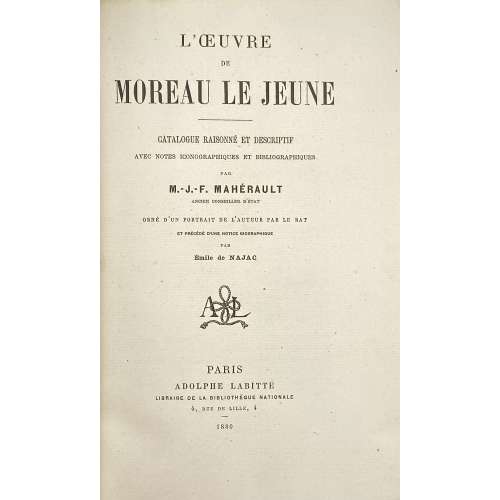 Binding: Hardcover, 25.5 x 17.8 x 4.7 cm, collated 4to, ¾ brown crushed morocco, bordered with gilt double fillet, raised bands, gilt fleurons in compartments, gelt lettering, marbled endpapers, top margin gilt; text printed on laid paper; frontis. on wove paper. Title-page: L'OEUVRE | DE | MOREAU LE JEUNE | — | CATALOGUE RAISONNÉ ET DESCRIPTIF | AVEC NOTES ICONOGRAPHIQUES ET BIBLIOGRAPHIQUES | PAR | M.- J.- F. MAHÉRAULT | ANCIEN CONSEILLER D’ÉTAT | ORNÉ D’UN PORTRAIT DE L’AUTEUR PAR LE RAT | ET PRÉCÉDÉ D’UNE NOTICE BIOGRAPHIQUE | PAR | Émile de Najac | {publisher’s device} | PARIS | ADOLPHE LABITTE | LIBRAIRE DE LA BIBLIOTHÈQUE NATIONALE | 4, RUE DE LILLE, 4 | – | 1880 || Collation: ffl, π2 (h.t., t.p.), a4 b2 1-674 682, 4ffl; total 278 leaves within flyleaves plus engraved frontispiece portrait of M.-J.-F. Mahérault by Paul Edme Le Rat w/tissue guard. Pagination: [4] [i] ii-xi [xii blank], [1] 2-538 (with page 538 erroneously numbered 568) [2 colophon/blank]; total 556 pages, ils. Contributors: Jean Michel Moreau [Moreau le Jeune] (French, 1741 – 1814) – artist, character. Marie Joseph François Mahérault (French, (1795 – 1879) – author, text. Comte Émile de Najac (French, 1828 – 1889) – author, biography. Paul-Edme Le Rat (French, 1849 – 1892) – artist, engraver. Adolphe Labitte (French, 1832 – 1882) – publisher. Georges Chamerot (French, 1845 – 1922) – printer.
Binding: Hardcover, 25.5 x 17.8 x 4.7 cm, collated 4to, ¾ brown crushed morocco, bordered with gilt double fillet, raised bands, gilt fleurons in compartments, gelt lettering, marbled endpapers, top margin gilt; text printed on laid paper; frontis. on wove paper. Title-page: L'OEUVRE | DE | MOREAU LE JEUNE | — | CATALOGUE RAISONNÉ ET DESCRIPTIF | AVEC NOTES ICONOGRAPHIQUES ET BIBLIOGRAPHIQUES | PAR | M.- J.- F. MAHÉRAULT | ANCIEN CONSEILLER D’ÉTAT | ORNÉ D’UN PORTRAIT DE L’AUTEUR PAR LE RAT | ET PRÉCÉDÉ D’UNE NOTICE BIOGRAPHIQUE | PAR | Émile de Najac | {publisher’s device} | PARIS | ADOLPHE LABITTE | LIBRAIRE DE LA BIBLIOTHÈQUE NATIONALE | 4, RUE DE LILLE, 4 | – | 1880 || Collation: ffl, π2 (h.t., t.p.), a4 b2 1-674 682, 4ffl; total 278 leaves within flyleaves plus engraved frontispiece portrait of M.-J.-F. Mahérault by Paul Edme Le Rat w/tissue guard. Pagination: [4] [i] ii-xi [xii blank], [1] 2-538 (with page 538 erroneously numbered 568) [2 colophon/blank]; total 556 pages, ils. Contributors: Jean Michel Moreau [Moreau le Jeune] (French, 1741 – 1814) – artist, character. Marie Joseph François Mahérault (French, (1795 – 1879) – author, text. Comte Émile de Najac (French, 1828 – 1889) – author, biography. Paul-Edme Le Rat (French, 1849 – 1892) – artist, engraver. Adolphe Labitte (French, 1832 – 1882) – publisher. Georges Chamerot (French, 1845 – 1922) – printer. -
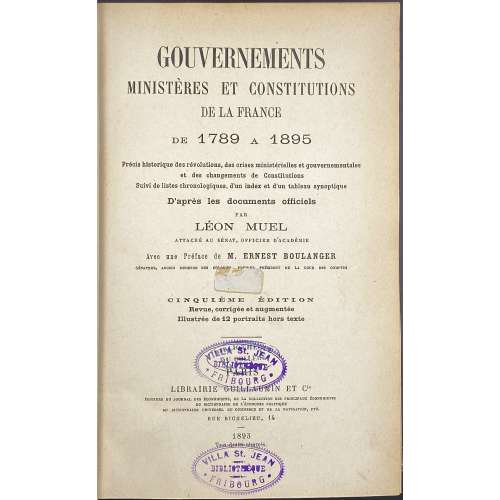 Title-page: GOUVERNEMENTS | MINISTÈRES ET CONSTITUTIONS | DE LA FRANCE | DE 1789 A 1895 | Précis historique des révolutions, des crises ministérielles et gouvernementales | et des changements de Constitutions | Suivi de listes chronologiques, d’un index et d’un tableau synoptique | D’après les documents officiels | PAR | LÉON MUEL | ATTACHÉ AU SÉNAT, OFFICIER D’ACADÉMIE | Avec une Préface de M. ERNEST BOULANGER | SÉNATEUR, ANCIEN MINISTRE DES COLONIES, PREMIER PRÉSIDENT DE LA COUR DES COMPTES | CINQUIÈME ÉDITION | Revue, corrigée et augmentée | Illustrée de 12 portraits hors texte | — | PARIS | LIBRAIRIE GUILLAUMIN ET Cie | ÉDITEURS DU JOURNAL DES ÉCONOMISTES, DE LA COLLECTION DES PRINCIPAUX ÉCONOMISTES | DU DICTIONNAIRE DE L’ÉCONOMIE POLITIQUE | DU DICTIONNAIRE UNIVERSEL DU COMMERCE ET DE LA NAVIGATION, ETC. | RUE RICHELIEU, 14 | 1895 | Tous droits réservés. || Binding: Hardcover, 22.1 x 16.6 cm x 5.0 cm, 8vo, quarter brown morocco over marbled boards, raised bands with gilt fillets and black label with gilt lettering to spine, marbled endpapers. Library stamps to t.p. and inside in blue ink: “VILLA St. JEAN | BIBLIOTHÈQUE | * FRIBOURG *”. Villa St. Jean International School, originally named Collège Villa St. Jean, was a private Catholic school in Fribourg, Switzerland, from 1903 to 1970 (see Wikipedia). Collation: ffl, π4, [1] 2-348, χ6, Suppl.: [1] 2-98, χ2, ffl; total within the flyleaves 282+76 leaves, some uncut; plus twelve plates (photographs) with tissue guards and two folding tables. Pagination: [i-v] vi-x, [2] [1] 2-4, (lacks 4: 5-8) [9] 10-535 [536] (lacks 2: 537, 538) [539] 540-557 [558 blank]; Supplément [1] 2-144, [145-6 table alphabét./blank], [147-8 table des matières/blank]; total within the flyleaves 564+148 pages, ils., plates. Provenance: Library of Villa St. Jean, Fribourg, Switzerland. Contributors: Muel, Léon (French, 1850 – 19..?) – author. Boulanger, Ernest-Théophile (French, 1831 – 1907) – author of preface. Librairie de Guillaumin et Cie – publisher. Table of contents:AVANT-PROPOSLETTRE-PRÉFACEPREMIÈRE PARTIEI. – MONARCHIE FRANÇAISE – BOURBONSLouis XVI, roi de France et de Navarre (10 MAI 1774 – 21 SEPTEMBRE 1792)II. – RÉPUBLIQUE FRANÇAISE (21 SEPTEMBRE 1792 – 18 MAI 1804)Convention nationale (20 SEPTEMBRE 1792 – 26 OCTOBRE 1795)Directoire exécutif (2 NOVEMBRE 1795 – 10 NOVEMBRE 1799)Consulat (19 BRUMAIRE AN VIII – 28 FLORÉAL AN XII) (10 NOVEMBRE 1799-18 MAI 1804);III. – EMPIRE FRANÇAIS (18 MAI 1804 – 31 MARS 1814)Napoléon Ier, Empereur des Français (18 MAI 1804 – 31 MARS 1814)Gouvernement provisoire (1er 14 AVRIL 1814)IV. – RESTAURATION – BOURBONS (14 AVRIL 1814 – 29 JUILLET 1830)Lieutenance générale du Royaume (14 AVRIL – 2 MAI 1814)Louis XVIII, roi de France et de Navarre (2 MAI 1814 – 20 MARS 1815)Cent Jours (20 MARS – 22 JUIN 1815)Commission de Gouvernement (22 JUIN – 7 JUILLET 1815)Louis XVIII, roi de France et de Navarre (8 JUILLET 1815 – 16 SEPTEMBRE 1824)Charles X, roi de France et de Navarre (16 SEPTEMBRE 1824 – 29 JUILLET 1830)Révolution de 1830Chute de Charles X et du ministère Polignac (29 JUILLET 1830). Gouvernement provisoire (29 – 31 JUILLET 1830)V. – MONARCHIE CONSTITUTIONNELLE – BRANCHE D'ORLÉANS (31 JUILLET 1830 – 24 FÉVRIER 1848)Lieutenance générale du Royaume (31 JUILLET – 9 AOUT 1830)Louis-Philippe Ier, roi des Français (9 AOUT 1830 – 24 FÉVRIER 1848)Révolution de 1848Chute du ministère Guizot (23 février) et du roi Louis-Philippe (24 février 1848)VI. – DEUXIÈME RÉPUBLIQUE FRANÇAISE (24 FÉVRIER 1848 – 2 DÉCEMBRE 1852)Gouvernement provisoire (24 FÉVRIER – 9 MAI 1848)Assemblée Nationale Constituante (4 MAI 1848 – 26 MAI 1849)Commission exécutive (9 MAI – 24 JUIN 1848)Le général Cavaignac chef du Pouvoir exécutif Président du Conseil des Ministres (28 JUIN – 20 DÉCEMBRE 1848)Louis-Napoléon Bonaparte Président de la République Française (20 DÉCEMBRE 1848 – 2 DÉCEMBRE 1852)VII. – SECOND EMPIRE FRANÇAIS (2 DÉCEMBRE 1852 – 4 SEPTEMBRE 1870)Napoléon III, empereur des Français (2 DÉCEMBRE 1852 – 4 SEPTEMBRE 1870)Révolution du 4 septembre 1870 Chute du second Empire et du ministère PalikaoVIII. – TROISIÈME RÉPUBLIQUE FRANÇAISE (4 SEPTEMBRE 1870)Gouvernement de la Défense nationale (4 SEPTEMBRE 1870 – 17 FÉVRIER 1871)Assemblée Nationale Constituante (13 FÉVRIER 1871 – 8 MARS 1876)M. Thiers Chef du Pouvoir exécutif (17 FÉVRIER – 31 AOUT 1871)M. Thiers Président de la République Française (31 AOUT 1871 – 24 MAI 1873)M. le Maréchal de Mac-Mahon, duc de Magenta Président de la République Française (24 MAI 1873 – 30 JANVIER 1879)M. Jules Grévy Président de la République Française (30 JANVIER 1879 – 2 DÉCEMBRE 1887)M. Carnot Président de la République française (3 DÉCEMBRE 1887 – 25 JUIN 1894)SECONDE PARTIE.Listes chronologiques, par ministère, de tous les ministres, depuis le 5 mai 1789 jusqu'en 1890
Title-page: GOUVERNEMENTS | MINISTÈRES ET CONSTITUTIONS | DE LA FRANCE | DE 1789 A 1895 | Précis historique des révolutions, des crises ministérielles et gouvernementales | et des changements de Constitutions | Suivi de listes chronologiques, d’un index et d’un tableau synoptique | D’après les documents officiels | PAR | LÉON MUEL | ATTACHÉ AU SÉNAT, OFFICIER D’ACADÉMIE | Avec une Préface de M. ERNEST BOULANGER | SÉNATEUR, ANCIEN MINISTRE DES COLONIES, PREMIER PRÉSIDENT DE LA COUR DES COMPTES | CINQUIÈME ÉDITION | Revue, corrigée et augmentée | Illustrée de 12 portraits hors texte | — | PARIS | LIBRAIRIE GUILLAUMIN ET Cie | ÉDITEURS DU JOURNAL DES ÉCONOMISTES, DE LA COLLECTION DES PRINCIPAUX ÉCONOMISTES | DU DICTIONNAIRE DE L’ÉCONOMIE POLITIQUE | DU DICTIONNAIRE UNIVERSEL DU COMMERCE ET DE LA NAVIGATION, ETC. | RUE RICHELIEU, 14 | 1895 | Tous droits réservés. || Binding: Hardcover, 22.1 x 16.6 cm x 5.0 cm, 8vo, quarter brown morocco over marbled boards, raised bands with gilt fillets and black label with gilt lettering to spine, marbled endpapers. Library stamps to t.p. and inside in blue ink: “VILLA St. JEAN | BIBLIOTHÈQUE | * FRIBOURG *”. Villa St. Jean International School, originally named Collège Villa St. Jean, was a private Catholic school in Fribourg, Switzerland, from 1903 to 1970 (see Wikipedia). Collation: ffl, π4, [1] 2-348, χ6, Suppl.: [1] 2-98, χ2, ffl; total within the flyleaves 282+76 leaves, some uncut; plus twelve plates (photographs) with tissue guards and two folding tables. Pagination: [i-v] vi-x, [2] [1] 2-4, (lacks 4: 5-8) [9] 10-535 [536] (lacks 2: 537, 538) [539] 540-557 [558 blank]; Supplément [1] 2-144, [145-6 table alphabét./blank], [147-8 table des matières/blank]; total within the flyleaves 564+148 pages, ils., plates. Provenance: Library of Villa St. Jean, Fribourg, Switzerland. Contributors: Muel, Léon (French, 1850 – 19..?) – author. Boulanger, Ernest-Théophile (French, 1831 – 1907) – author of preface. Librairie de Guillaumin et Cie – publisher. Table of contents:AVANT-PROPOSLETTRE-PRÉFACEPREMIÈRE PARTIEI. – MONARCHIE FRANÇAISE – BOURBONSLouis XVI, roi de France et de Navarre (10 MAI 1774 – 21 SEPTEMBRE 1792)II. – RÉPUBLIQUE FRANÇAISE (21 SEPTEMBRE 1792 – 18 MAI 1804)Convention nationale (20 SEPTEMBRE 1792 – 26 OCTOBRE 1795)Directoire exécutif (2 NOVEMBRE 1795 – 10 NOVEMBRE 1799)Consulat (19 BRUMAIRE AN VIII – 28 FLORÉAL AN XII) (10 NOVEMBRE 1799-18 MAI 1804);III. – EMPIRE FRANÇAIS (18 MAI 1804 – 31 MARS 1814)Napoléon Ier, Empereur des Français (18 MAI 1804 – 31 MARS 1814)Gouvernement provisoire (1er 14 AVRIL 1814)IV. – RESTAURATION – BOURBONS (14 AVRIL 1814 – 29 JUILLET 1830)Lieutenance générale du Royaume (14 AVRIL – 2 MAI 1814)Louis XVIII, roi de France et de Navarre (2 MAI 1814 – 20 MARS 1815)Cent Jours (20 MARS – 22 JUIN 1815)Commission de Gouvernement (22 JUIN – 7 JUILLET 1815)Louis XVIII, roi de France et de Navarre (8 JUILLET 1815 – 16 SEPTEMBRE 1824)Charles X, roi de France et de Navarre (16 SEPTEMBRE 1824 – 29 JUILLET 1830)Révolution de 1830Chute de Charles X et du ministère Polignac (29 JUILLET 1830). Gouvernement provisoire (29 – 31 JUILLET 1830)V. – MONARCHIE CONSTITUTIONNELLE – BRANCHE D'ORLÉANS (31 JUILLET 1830 – 24 FÉVRIER 1848)Lieutenance générale du Royaume (31 JUILLET – 9 AOUT 1830)Louis-Philippe Ier, roi des Français (9 AOUT 1830 – 24 FÉVRIER 1848)Révolution de 1848Chute du ministère Guizot (23 février) et du roi Louis-Philippe (24 février 1848)VI. – DEUXIÈME RÉPUBLIQUE FRANÇAISE (24 FÉVRIER 1848 – 2 DÉCEMBRE 1852)Gouvernement provisoire (24 FÉVRIER – 9 MAI 1848)Assemblée Nationale Constituante (4 MAI 1848 – 26 MAI 1849)Commission exécutive (9 MAI – 24 JUIN 1848)Le général Cavaignac chef du Pouvoir exécutif Président du Conseil des Ministres (28 JUIN – 20 DÉCEMBRE 1848)Louis-Napoléon Bonaparte Président de la République Française (20 DÉCEMBRE 1848 – 2 DÉCEMBRE 1852)VII. – SECOND EMPIRE FRANÇAIS (2 DÉCEMBRE 1852 – 4 SEPTEMBRE 1870)Napoléon III, empereur des Français (2 DÉCEMBRE 1852 – 4 SEPTEMBRE 1870)Révolution du 4 septembre 1870 Chute du second Empire et du ministère PalikaoVIII. – TROISIÈME RÉPUBLIQUE FRANÇAISE (4 SEPTEMBRE 1870)Gouvernement de la Défense nationale (4 SEPTEMBRE 1870 – 17 FÉVRIER 1871)Assemblée Nationale Constituante (13 FÉVRIER 1871 – 8 MARS 1876)M. Thiers Chef du Pouvoir exécutif (17 FÉVRIER – 31 AOUT 1871)M. Thiers Président de la République Française (31 AOUT 1871 – 24 MAI 1873)M. le Maréchal de Mac-Mahon, duc de Magenta Président de la République Française (24 MAI 1873 – 30 JANVIER 1879)M. Jules Grévy Président de la République Française (30 JANVIER 1879 – 2 DÉCEMBRE 1887)M. Carnot Président de la République française (3 DÉCEMBRE 1887 – 25 JUIN 1894)SECONDE PARTIE.Listes chronologiques, par ministère, de tous les ministres, depuis le 5 mai 1789 jusqu'en 1890 -
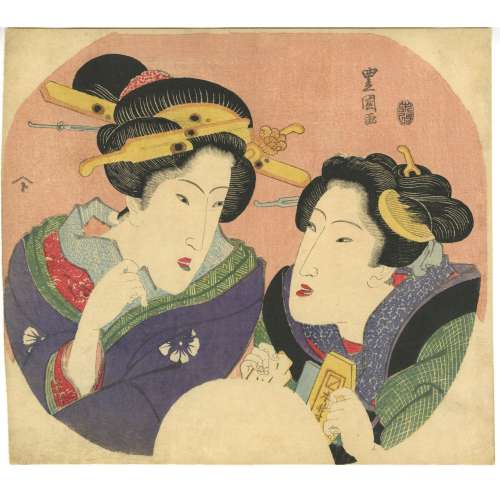 Artist: Utagawa Toyokuni I [歌川豊国] (1769–1825). Pubisher: Enshūya Matabei (遠州屋又兵衛) (c. 1768 – 1881), seal name: Enmata [ 遠又]. Signed: Toyokuni ga [豊国画]. Date-aratame censor seal: 未改, Bunsei 6 (1823). Size: uchiwa-e; 233 x 262 mm. Ref: Israel Goldman. Japanese Prints, Paintings and Books / Catalogue 28, 2022: № 14.
Artist: Utagawa Toyokuni I [歌川豊国] (1769–1825). Pubisher: Enshūya Matabei (遠州屋又兵衛) (c. 1768 – 1881), seal name: Enmata [ 遠又]. Signed: Toyokuni ga [豊国画]. Date-aratame censor seal: 未改, Bunsei 6 (1823). Size: uchiwa-e; 233 x 262 mm. Ref: Israel Goldman. Japanese Prints, Paintings and Books / Catalogue 28, 2022: № 14. -
 Title: Modori Kago [戻駕] (Returning palanquin). The dance-drama Modori Kago Iro ni Aikata [戻駕色相肩] premiered in the 11th lunar month of 1788 at the Nakamuraza [中村座], within Sakurada Jisuke I's kaomise [顔見世] (faceshowing) program Tôzumô Hana no Edogata [唐相撲花江戸方]", which celebrated the homecoming to Edo, after two years' absence, of Nakamura Nakazō I, and was intended to show off his particular talents in the role of Jirosaku (in reality Ishikawa Goemon [石川 五右衛門]) [kabuki21]. The symbol on a green book cover is the informal crest of tokiwazu-bushi [常磐津節] shaped like a water chestnut (Eleocharis dulcis) lozenge. Artist signature 国盛画 (Kunimori ga) with red toshidama. According to Samuel L. Leiter’s Kabuki Encyclopedia (1979), p. 243: The palanquin bearers Nanpa no Jirosaku and Azuma no Yōshirō, who are bearing a palanquin with a courtesan's young handmaiden in it, stop to rest at Kyoto's Murasakino, and each dances his regional dance. Then they call the girl, who does a dance showing the visitors to the famous pleasure quarters, Yoshiwara and Shimabara. The two men recognize each other as Ishikawa Goemon and Masashiba Hisayoshi, sworn enemies, and engage in a fight. This number is the only remaining section of an annual "faceshowing” (kaomize) work with a plot based on the medieval chronicle called the Toikōki. The full-length piece was called Kara Sumō Hanaeda no Kata. It is one of the most famous tokiwazu pieces and preserves the old-style Kabuki flavour. Nakamura Nakazō I played Jirosaku and Matsumoto Kōshirō IV was Yoshiro in the first production. The handmaiden was Matsumoto Komesaburō (probably Matsumoto Komasaburō I, an unknown actor [SV]). According to Egenolf Gallery: This work was first performed in 1788 at the Edo Nakamura-za as the season’s first performance and featured Nakamura Nakazō, who returned to Edo after three years in Osaka. It was a dance with tokiwazu chanting and was designed for him to play the lead role. In the piece, two palanquin carriers, one from Osaka, another from Edo, and a passenger – a kamuro, (a young geisha-in-training) exchange stories about the pleasure quarters of Shimabara and Yoshiwara. The text of the chanting book is open next to her, carrying the title “Collection of Practicing” [稽古尽くし], on which the green bundle cover carries the crest of Tokiwazu School, matsu-kawa-bishi, diamond variety of pine bark and the artist’s signature. Tokiwazu is a type of jōruri, narrative music, and accompanies dancing on the kabuki stage. Ref.: Christie's 27 Mar 2006. Publisher: Maruya Jinpachi, seal Marujin (Marks: 12-029 | 294e) Single nanushi censor seal: Mura (Murata Sahei, 1842-46). Provenance: Circular seal of the collector Huguette Bérès to verso. Contributors: Utagawa Kunimori [歌川国盛] (Japanese, fl. c. 1818 – 1943) – artist. Maruya Jinpachi [丸屋甚八] (Japanese, fl. 1770 – 1842) – publisher. Other mentioned: Nakamura Nakazō I [中村仲蔵] (Japanese, 1736 – 1790); other names: Nakayama Kojūrō VI, Nakamura Ichijūrō, Nakayama Manzō – actor. Matsumoto Kōshirō IV [松本幸四郎] (Japanese, 1737 – 1802); other names: Omegawa Kyōjūrō; Ichikawa Komazō II, Ichikawa Somegorô I, Ichikawa Takejūrō ; Segawa Kinji; Segawa Kingo – actor. Sakurada Jisuke I [桜田治助] (Japanese, 1734 – 1806) – dramatist.
Title: Modori Kago [戻駕] (Returning palanquin). The dance-drama Modori Kago Iro ni Aikata [戻駕色相肩] premiered in the 11th lunar month of 1788 at the Nakamuraza [中村座], within Sakurada Jisuke I's kaomise [顔見世] (faceshowing) program Tôzumô Hana no Edogata [唐相撲花江戸方]", which celebrated the homecoming to Edo, after two years' absence, of Nakamura Nakazō I, and was intended to show off his particular talents in the role of Jirosaku (in reality Ishikawa Goemon [石川 五右衛門]) [kabuki21]. The symbol on a green book cover is the informal crest of tokiwazu-bushi [常磐津節] shaped like a water chestnut (Eleocharis dulcis) lozenge. Artist signature 国盛画 (Kunimori ga) with red toshidama. According to Samuel L. Leiter’s Kabuki Encyclopedia (1979), p. 243: The palanquin bearers Nanpa no Jirosaku and Azuma no Yōshirō, who are bearing a palanquin with a courtesan's young handmaiden in it, stop to rest at Kyoto's Murasakino, and each dances his regional dance. Then they call the girl, who does a dance showing the visitors to the famous pleasure quarters, Yoshiwara and Shimabara. The two men recognize each other as Ishikawa Goemon and Masashiba Hisayoshi, sworn enemies, and engage in a fight. This number is the only remaining section of an annual "faceshowing” (kaomize) work with a plot based on the medieval chronicle called the Toikōki. The full-length piece was called Kara Sumō Hanaeda no Kata. It is one of the most famous tokiwazu pieces and preserves the old-style Kabuki flavour. Nakamura Nakazō I played Jirosaku and Matsumoto Kōshirō IV was Yoshiro in the first production. The handmaiden was Matsumoto Komesaburō (probably Matsumoto Komasaburō I, an unknown actor [SV]). According to Egenolf Gallery: This work was first performed in 1788 at the Edo Nakamura-za as the season’s first performance and featured Nakamura Nakazō, who returned to Edo after three years in Osaka. It was a dance with tokiwazu chanting and was designed for him to play the lead role. In the piece, two palanquin carriers, one from Osaka, another from Edo, and a passenger – a kamuro, (a young geisha-in-training) exchange stories about the pleasure quarters of Shimabara and Yoshiwara. The text of the chanting book is open next to her, carrying the title “Collection of Practicing” [稽古尽くし], on which the green bundle cover carries the crest of Tokiwazu School, matsu-kawa-bishi, diamond variety of pine bark and the artist’s signature. Tokiwazu is a type of jōruri, narrative music, and accompanies dancing on the kabuki stage. Ref.: Christie's 27 Mar 2006. Publisher: Maruya Jinpachi, seal Marujin (Marks: 12-029 | 294e) Single nanushi censor seal: Mura (Murata Sahei, 1842-46). Provenance: Circular seal of the collector Huguette Bérès to verso. Contributors: Utagawa Kunimori [歌川国盛] (Japanese, fl. c. 1818 – 1943) – artist. Maruya Jinpachi [丸屋甚八] (Japanese, fl. 1770 – 1842) – publisher. Other mentioned: Nakamura Nakazō I [中村仲蔵] (Japanese, 1736 – 1790); other names: Nakayama Kojūrō VI, Nakamura Ichijūrō, Nakayama Manzō – actor. Matsumoto Kōshirō IV [松本幸四郎] (Japanese, 1737 – 1802); other names: Omegawa Kyōjūrō; Ichikawa Komazō II, Ichikawa Somegorô I, Ichikawa Takejūrō ; Segawa Kinji; Segawa Kingo – actor. Sakurada Jisuke I [桜田治助] (Japanese, 1734 – 1806) – dramatist. -
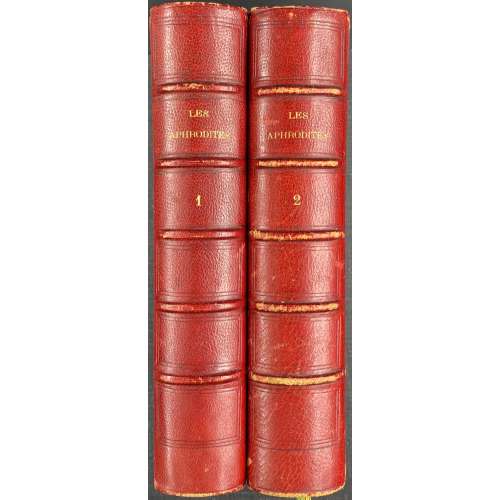 Two volumes in-12, 16.7 x 11.5 x 3.5 cm each, uniformly bound in quarter crimson morocco over marbled boards, spine with raised bands, gilt lettering, marbled endpapers, top margin gilt; text printed on laid paper, plates – on India paper: loose frontispiece by Félix Lukkow after Félicien Rops with tissue guard and 4 loose engraved plates by Félix Lukkow after Sigmund Freudenberger, in each volume. This edition is a reprint of an earlier publication: ANDRÉA DE NERCIAT, André-Robert (1739 - 1800). Les Aphrodites ou Fragments thali-priapiques pour servir à l'histoire du plaisir. Numéro Un et deux [Numéro trois et quatre [...] sept et huit]. 1793-1864. [Bruxelles : Briard pour Poulet-Malassis, 1864] with plated recarved by Félix Lukkow. Title-page: LES | APHRODITES | OU | FRAGMENTS THALI-PRIAPIQUES | POUR SERVIR A | L’HISTOIRE DU PLAISIR | — | Priape, soutiens mon hàleine… | Piron, Ode | — | Tome premier (second). | {publisher’s device} | A LAMPSAQUE | – | 1793 || Limitation: Edition is limited to 150 copies of which 130 on papier vergé, 5 on papier album jaune, 10 copies in-8o on large papier fort de Hollande, and one unique copy on peau de vélin. The number of this copy is left blank in both volumes. Vol. 1: π4 (h.t./limit., t.p./table, Éclaircissements historiques par V. M. D.), 1-2712 2910; total 182 leaves plus 5 leaves of plates, incl. frontispiece. Pagination: [1-5] 6-364, ils. V. M. D. stands for Vital Désiré Maximilien [Puissant]. Vol. 2: π2 (h.t., t.p.), 1-2912, 3110; total 192 leaves plus 5 leaves of plates, incl. frontispiece. Pagination: [1-5] 6-384, ils. Catalogue raisonné: Dutel I: A-95. Catalogue Poulet-Malassis & ses amis description: № 67. André-Robert ANDRÉA DE NERCIAT - [Félix LUKKOW]. Les Aphrodites, ou fragments thali-priapiques pour servir à l’histoire du plaisir. Tome premier (— second). A Lampsaque, 1793 [Vital Puissant, vers 1872]. 2 volumes in-12 de 364 et 384 pages, demi-maroquin rouge, dos à nerfs, tête dorée, non rogné (reliure de l’époque). Illustré de 2 frontispices et 8 planches volantes, par Félix Lukkow, d’après Félicien Rops pour les frontispices et Freundeberg pour les figures. Tirage limité à 151 ex. Contributors: André-Robert Andréa de Nerciat (French, 1739 – 1800) – author. Sigmund Freudenberger (Swiss, 1745 – 1801) – artist. Félicien Rops (Belgian, 1833 – 1898) – artist. Félix Lukkow (French, fl. c. 1870 – 1875) – engraver.
Two volumes in-12, 16.7 x 11.5 x 3.5 cm each, uniformly bound in quarter crimson morocco over marbled boards, spine with raised bands, gilt lettering, marbled endpapers, top margin gilt; text printed on laid paper, plates – on India paper: loose frontispiece by Félix Lukkow after Félicien Rops with tissue guard and 4 loose engraved plates by Félix Lukkow after Sigmund Freudenberger, in each volume. This edition is a reprint of an earlier publication: ANDRÉA DE NERCIAT, André-Robert (1739 - 1800). Les Aphrodites ou Fragments thali-priapiques pour servir à l'histoire du plaisir. Numéro Un et deux [Numéro trois et quatre [...] sept et huit]. 1793-1864. [Bruxelles : Briard pour Poulet-Malassis, 1864] with plated recarved by Félix Lukkow. Title-page: LES | APHRODITES | OU | FRAGMENTS THALI-PRIAPIQUES | POUR SERVIR A | L’HISTOIRE DU PLAISIR | — | Priape, soutiens mon hàleine… | Piron, Ode | — | Tome premier (second). | {publisher’s device} | A LAMPSAQUE | – | 1793 || Limitation: Edition is limited to 150 copies of which 130 on papier vergé, 5 on papier album jaune, 10 copies in-8o on large papier fort de Hollande, and one unique copy on peau de vélin. The number of this copy is left blank in both volumes. Vol. 1: π4 (h.t./limit., t.p./table, Éclaircissements historiques par V. M. D.), 1-2712 2910; total 182 leaves plus 5 leaves of plates, incl. frontispiece. Pagination: [1-5] 6-364, ils. V. M. D. stands for Vital Désiré Maximilien [Puissant]. Vol. 2: π2 (h.t., t.p.), 1-2912, 3110; total 192 leaves plus 5 leaves of plates, incl. frontispiece. Pagination: [1-5] 6-384, ils. Catalogue raisonné: Dutel I: A-95. Catalogue Poulet-Malassis & ses amis description: № 67. André-Robert ANDRÉA DE NERCIAT - [Félix LUKKOW]. Les Aphrodites, ou fragments thali-priapiques pour servir à l’histoire du plaisir. Tome premier (— second). A Lampsaque, 1793 [Vital Puissant, vers 1872]. 2 volumes in-12 de 364 et 384 pages, demi-maroquin rouge, dos à nerfs, tête dorée, non rogné (reliure de l’époque). Illustré de 2 frontispices et 8 planches volantes, par Félix Lukkow, d’après Félicien Rops pour les frontispices et Freundeberg pour les figures. Tirage limité à 151 ex. Contributors: André-Robert Andréa de Nerciat (French, 1739 – 1800) – author. Sigmund Freudenberger (Swiss, 1745 – 1801) – artist. Félicien Rops (Belgian, 1833 – 1898) – artist. Félix Lukkow (French, fl. c. 1870 – 1875) – engraver. -
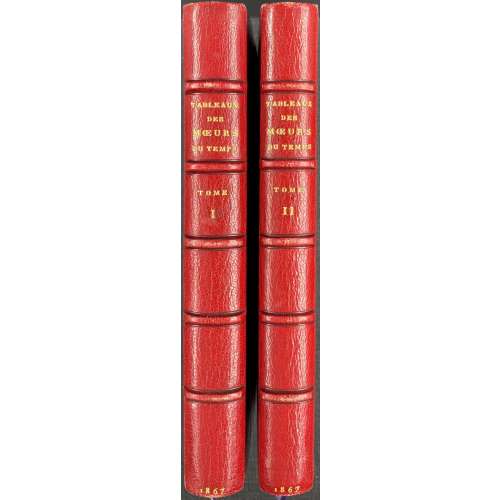 Two volumes in-12, 16.8 x 11.5 cm each, uniformly bound in ¾ red crushed morocco over marbled boards, spine with raised bands and gilt lettering, marbled endpapers, text printed on laid paper, 6 plates (3 in each vol.) on India paper pasted in on thick laid paper leaves. This edition seems similar to Nordmann I 203 but without Félicien Rops' frontispiece and plates, replaced by unsigned etchings attributed to Gustave Staal. Title-page (red and black): LE RICHE DE LA POPELINIÈRE | – | TABLEAUX | DES | MŒURS DU TEMPS | DANS LES DIFFÉRENTS AGES DE LA VIE | – | NOTICE DE | CHARLES MONSELET | – | TOME PREMIER (SECOND) | {fleuron} | PARIS | IMPRIMERIE DES CI-DEVANT FERMIERS GÉNÉRAUX | – | M D CCC L XVII || Vol. 1: π2 (h.t., t.p.) a4 (Notice), 1-1312 151 (Table); total 91 leaves plus three leaves of plates. Pagination: [4] [i] ii-vii [viii] [3] 4-168 [2]; total 182 pp, ils. facing pp. 59, 78, and 94. Vol. 2: π2 (h.t., t.p.), 1-1312, 152; total 88 leaves plus three leaves of plates. Pagination: [4] [1] 2-170 [2]; total 176 pp, ils. facing pp. 74, 78, and 145. Catalogue raisonné: Dutel I: A-1044 — without Félicien Rops ‘ornementations’, but with ‘6 gravures de 1865’. Dutel suggests that the edition was performed by A. Poulet-Malassis, Briard or Lécrivain. Catalogue Poulet-Malassis & ses amis description: № 43. LE RICHE DE LA POPELINIÈRE. Tableaux des mœurs du temps dans les diérents âges de la vie, tome premier (— second). Notice de M. Charles Monselet. Imprimerie des ci-devant fermiers généraux, Paris, M D CCC LXVII [A. Poulet-Malassis, 1867]. Exemplaire sans le frontispice de Félicien Rops mais bien complet des 6 figures de Staal, justification qui illustre les aléas de la confection des publications clandestines. D’une part, c’est une autre édition qui est décrite par Launay. L’exemplaire vendu chez Maître Loudmer avait 6 figures, comme ici. Cluzel a vu un “front. et 4 vignettes de Rops plus cinq figures libres (par Staal)”, Simonson a vu 5 figures de Rops, etc., etc. Il y a 3 bandeaux et 3 culs-de-lampe de Rops qui ont été fréquemment utilisés par d’autres éditeurs pour d’autres titres pendant toute la seconde moitié du xixe siècle. La Léonina présente une fiche détaillée sur 4 pages. 3 bandeaux et 3 culs-de-lampe gravés sur bois de Rops. Bibliographie : Pia 1389, Launay 327, Gay 6-308, Pey 122 (1800 frs avec 5 figures), PC 503 et 504, Lemonnyer 3-1173, LL 66, Leonina 81, Nordmann 1-203, Dutel A-1043. Contributors: Alexandre Jean Joseph Le Riche de La Popelinière (French, 1693 – 1762) – author. Charles Monselet (French, 1825 – 1888) – author (foreword). Pierre-Gustave-Eugène Staal (French, 1817 – 1882) – artist. Auguste Poulet-Malassis (French, 1825 – 1878) – publisher.
Two volumes in-12, 16.8 x 11.5 cm each, uniformly bound in ¾ red crushed morocco over marbled boards, spine with raised bands and gilt lettering, marbled endpapers, text printed on laid paper, 6 plates (3 in each vol.) on India paper pasted in on thick laid paper leaves. This edition seems similar to Nordmann I 203 but without Félicien Rops' frontispiece and plates, replaced by unsigned etchings attributed to Gustave Staal. Title-page (red and black): LE RICHE DE LA POPELINIÈRE | – | TABLEAUX | DES | MŒURS DU TEMPS | DANS LES DIFFÉRENTS AGES DE LA VIE | – | NOTICE DE | CHARLES MONSELET | – | TOME PREMIER (SECOND) | {fleuron} | PARIS | IMPRIMERIE DES CI-DEVANT FERMIERS GÉNÉRAUX | – | M D CCC L XVII || Vol. 1: π2 (h.t., t.p.) a4 (Notice), 1-1312 151 (Table); total 91 leaves plus three leaves of plates. Pagination: [4] [i] ii-vii [viii] [3] 4-168 [2]; total 182 pp, ils. facing pp. 59, 78, and 94. Vol. 2: π2 (h.t., t.p.), 1-1312, 152; total 88 leaves plus three leaves of plates. Pagination: [4] [1] 2-170 [2]; total 176 pp, ils. facing pp. 74, 78, and 145. Catalogue raisonné: Dutel I: A-1044 — without Félicien Rops ‘ornementations’, but with ‘6 gravures de 1865’. Dutel suggests that the edition was performed by A. Poulet-Malassis, Briard or Lécrivain. Catalogue Poulet-Malassis & ses amis description: № 43. LE RICHE DE LA POPELINIÈRE. Tableaux des mœurs du temps dans les diérents âges de la vie, tome premier (— second). Notice de M. Charles Monselet. Imprimerie des ci-devant fermiers généraux, Paris, M D CCC LXVII [A. Poulet-Malassis, 1867]. Exemplaire sans le frontispice de Félicien Rops mais bien complet des 6 figures de Staal, justification qui illustre les aléas de la confection des publications clandestines. D’une part, c’est une autre édition qui est décrite par Launay. L’exemplaire vendu chez Maître Loudmer avait 6 figures, comme ici. Cluzel a vu un “front. et 4 vignettes de Rops plus cinq figures libres (par Staal)”, Simonson a vu 5 figures de Rops, etc., etc. Il y a 3 bandeaux et 3 culs-de-lampe de Rops qui ont été fréquemment utilisés par d’autres éditeurs pour d’autres titres pendant toute la seconde moitié du xixe siècle. La Léonina présente une fiche détaillée sur 4 pages. 3 bandeaux et 3 culs-de-lampe gravés sur bois de Rops. Bibliographie : Pia 1389, Launay 327, Gay 6-308, Pey 122 (1800 frs avec 5 figures), PC 503 et 504, Lemonnyer 3-1173, LL 66, Leonina 81, Nordmann 1-203, Dutel A-1043. Contributors: Alexandre Jean Joseph Le Riche de La Popelinière (French, 1693 – 1762) – author. Charles Monselet (French, 1825 – 1888) – author (foreword). Pierre-Gustave-Eugène Staal (French, 1817 – 1882) – artist. Auguste Poulet-Malassis (French, 1825 – 1878) – publisher. -
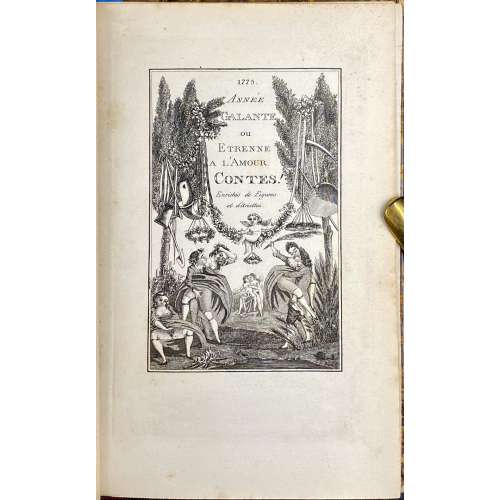 Single volume, 20 x 13 cm, quarter brown morocco over marbled boards tooled in gilt, spine with raised bands, gilt in compartments, and gilt lettering, marbled endpapers, printed on wove paper on recto with verso blank, collated 1-48; total 32 leaves, 11 torn off, 47,8 blanks, ; uneven pagination [1] 2-41 [4 blanks], plus engraved title-page and 12 engraved half-page plates with text, uncoloured, by Louis Jaugey (unsigned), one for each month. Title-page (engraved): vignette with lettering "1775. ANNÉE | GALANTE | OU | ETRENNE | A L'AMOUR | CONTES! | Enrichis de Figures | et d'Ariettes. ||" Catalogue raisonné: Dutel I: A-82. Catalogue Poulet-Malassis & ses amis description: № 68. [Auteur inconnu]. Année galante ou Etrenne à l’amour. Contes, enrichis de Figures et d’Ariees. [Vital Puissant, Bruxelles, 1876 ?] 1775. In-8, 3 .n.ch., 29 . imprimés au recto, chirés de 2 à 41, demi-chagrin brun, dos à nerfs orné, let doré sur les mors, tête et tranches jaspées (reliure ancienne). Illustrée de 13 planches dont l’une en frontispice par Louis Jaugey. Les figures sont à mi-page, une pour chaque mois. Contributors: Louis Jaugey (French, fl. 1871 – 1876) – artist. Vital Puissant (Belgian, 1835 – 1878) – publisher.
Single volume, 20 x 13 cm, quarter brown morocco over marbled boards tooled in gilt, spine with raised bands, gilt in compartments, and gilt lettering, marbled endpapers, printed on wove paper on recto with verso blank, collated 1-48; total 32 leaves, 11 torn off, 47,8 blanks, ; uneven pagination [1] 2-41 [4 blanks], plus engraved title-page and 12 engraved half-page plates with text, uncoloured, by Louis Jaugey (unsigned), one for each month. Title-page (engraved): vignette with lettering "1775. ANNÉE | GALANTE | OU | ETRENNE | A L'AMOUR | CONTES! | Enrichis de Figures | et d'Ariettes. ||" Catalogue raisonné: Dutel I: A-82. Catalogue Poulet-Malassis & ses amis description: № 68. [Auteur inconnu]. Année galante ou Etrenne à l’amour. Contes, enrichis de Figures et d’Ariees. [Vital Puissant, Bruxelles, 1876 ?] 1775. In-8, 3 .n.ch., 29 . imprimés au recto, chirés de 2 à 41, demi-chagrin brun, dos à nerfs orné, let doré sur les mors, tête et tranches jaspées (reliure ancienne). Illustrée de 13 planches dont l’une en frontispice par Louis Jaugey. Les figures sont à mi-page, une pour chaque mois. Contributors: Louis Jaugey (French, fl. 1871 – 1876) – artist. Vital Puissant (Belgian, 1835 – 1878) – publisher. -
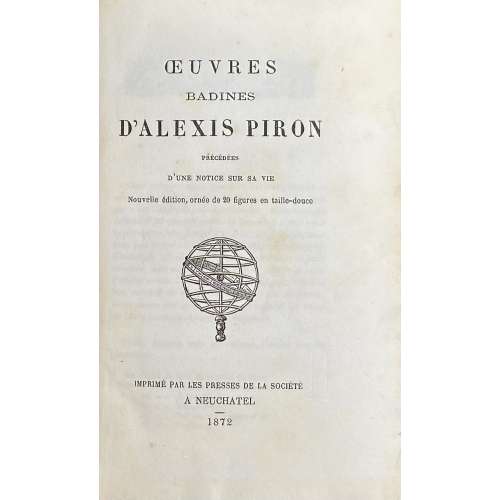 Single volume, 17.1 x 11.2 cm, quarter black sheepskin over faux chagrin, gilt lettering to spine, marbled endpapers, bottom and outer margin untrimmed, pp.: [i-v] vi- xxxvi, [1] 2-218 [2], collated 4to: π2, a-d4, 1-274 282, total 256 pages or 128 leaves, plus 20 engraved plates by Paul Sellier, including frontispiece portrait of Alexis Piron after bust by Caffieri. Vol. 8 of Bibliothèque Libre, Œuvres badines de Piron, printed on February 15, 1872. Text printed on dense wove paper watermarked P or M, plates printed on India wove paper. A reprint of an edition published in 1796 plus illustrations. Title-page: ŒUVRES | BADINES | D’ALEXIS PIRON | PRÉCÉDÉES | D’UNE NOTICE SUR SA VIE | Nouvelle édition, ornée de 20 figures en taille-douce | {vignette} | IMPRIMÉ PAR LES PRESSES DE LA SOCIÉTÉ | A NEUCHATEL | – | 1872 || Limitation: 100 numbered copies, of which this is № 75. Catalogue raisonné: Dutel I: A-788; Pia: 953-6; Kearney 377 (Patrick J. Kearney. A Catalogue of the publications of Jules Gay, Jean-Jules Gay & Gay et Doucé, revised & expanded. — Santa Rosa, CA Scissors & Paste Bibliographies, 2019) Catalogue Poulet-Malassis & ses amis description: № 81. Alexis PIRON. Œuvres badines précédées d’une notice sur sa vie. Nouvelle édition ornée de 20 figures en taille-douce. [ Jules Gay] Imprimé par les presses de la société, à Neufchatel, 1872. In-8, xxxvi, 218 pages et un feuillet d’achevé d’imprimer de table, demi-basane noire, dos à faux nerfs, tête et tranches naturelles. Illustré d’un portrait et de 20 figures par Paul Sellier. Tirage limité à 100 ex. numérotés. De la « Bibliothèque libre ou collection choisie d’ouvrages du genre libre, imprimés ou réimprimés par les soins de la Société des Bibliophiles Cosmopolites et pour les membres de cette société, à cent exemplaires numérotés ». Bibliographie : Pia 1030, Enfer 1274, Lem 3-454, Gay 5-339, PC 353, G* 38, Pey 203, Dutel A-788." Contributors: Alexis Piron (French, 1689 – 1773) – author. Paul Sellier (French, 1842 – 19..?) – artist. Jules Léopold Gay (French, 1807 – 1887) – publisher.
Single volume, 17.1 x 11.2 cm, quarter black sheepskin over faux chagrin, gilt lettering to spine, marbled endpapers, bottom and outer margin untrimmed, pp.: [i-v] vi- xxxvi, [1] 2-218 [2], collated 4to: π2, a-d4, 1-274 282, total 256 pages or 128 leaves, plus 20 engraved plates by Paul Sellier, including frontispiece portrait of Alexis Piron after bust by Caffieri. Vol. 8 of Bibliothèque Libre, Œuvres badines de Piron, printed on February 15, 1872. Text printed on dense wove paper watermarked P or M, plates printed on India wove paper. A reprint of an edition published in 1796 plus illustrations. Title-page: ŒUVRES | BADINES | D’ALEXIS PIRON | PRÉCÉDÉES | D’UNE NOTICE SUR SA VIE | Nouvelle édition, ornée de 20 figures en taille-douce | {vignette} | IMPRIMÉ PAR LES PRESSES DE LA SOCIÉTÉ | A NEUCHATEL | – | 1872 || Limitation: 100 numbered copies, of which this is № 75. Catalogue raisonné: Dutel I: A-788; Pia: 953-6; Kearney 377 (Patrick J. Kearney. A Catalogue of the publications of Jules Gay, Jean-Jules Gay & Gay et Doucé, revised & expanded. — Santa Rosa, CA Scissors & Paste Bibliographies, 2019) Catalogue Poulet-Malassis & ses amis description: № 81. Alexis PIRON. Œuvres badines précédées d’une notice sur sa vie. Nouvelle édition ornée de 20 figures en taille-douce. [ Jules Gay] Imprimé par les presses de la société, à Neufchatel, 1872. In-8, xxxvi, 218 pages et un feuillet d’achevé d’imprimer de table, demi-basane noire, dos à faux nerfs, tête et tranches naturelles. Illustré d’un portrait et de 20 figures par Paul Sellier. Tirage limité à 100 ex. numérotés. De la « Bibliothèque libre ou collection choisie d’ouvrages du genre libre, imprimés ou réimprimés par les soins de la Société des Bibliophiles Cosmopolites et pour les membres de cette société, à cent exemplaires numérotés ». Bibliographie : Pia 1030, Enfer 1274, Lem 3-454, Gay 5-339, PC 353, G* 38, Pey 203, Dutel A-788." Contributors: Alexis Piron (French, 1689 – 1773) – author. Paul Sellier (French, 1842 – 19..?) – artist. Jules Léopold Gay (French, 1807 – 1887) – publisher. -
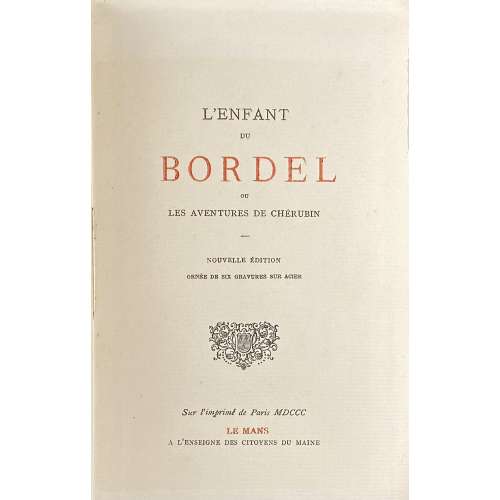 Softcover volume, 17.5 x 11 cm, in-12, brown wrappers without lettering, text printed on laid paper, six plates on India paper barbarously glued in, pp.: fep, [4] (h.t. t.p.), [1-3] 4-182, fep. Title-page (red and black): L’ENFANT | DU | BORDEL | OU | LES AVENTURES DE CHÉRUBIN | – | NOUVELLE ÉDITION | ORNÉE DE SIX GRAVURES SUR ACIER | {fleuron} | Sur l’imprimé de Paris MDCCC | LE MANS | A L’ENSEIGNE DES CITOYENS DU MAINE || Catalogue raisonné: Dutel I: A-325; Pia 395: 222 pages (we have 182 as per Dutel), attributes publication to Poulet-Malassis, 1866. Catalogue Poulet-Malassis & ses amis description: № 82.[PIGAULT-LEBRUN]. L’Enfant du Bordel, ou Les Aventures de Chérubin, nouvelle édition, ornée de six gravures sur acier. Sur l’imprimé de Paris, MDCCC, Le Mans, à l’enseigne des citoyens du Maine. [A. Christiaens, 1875 ?]. In-12, broché. 2 .n.ch., 182 pages, 1 f. blanc, couverture muette en papier vieux orange. Illustré de 6 figures hors-texte sur acier. Bibliographie : G* 553 (40 frs), Dutel A-325. Contributors: Guillaume Charles Antoine Pigault de l'Espinoy [Pigault-Lebrun] (French, 1753 – 1835) – author. Alexis Christiaens (Belgian, d. 1880) – publisher.
Softcover volume, 17.5 x 11 cm, in-12, brown wrappers without lettering, text printed on laid paper, six plates on India paper barbarously glued in, pp.: fep, [4] (h.t. t.p.), [1-3] 4-182, fep. Title-page (red and black): L’ENFANT | DU | BORDEL | OU | LES AVENTURES DE CHÉRUBIN | – | NOUVELLE ÉDITION | ORNÉE DE SIX GRAVURES SUR ACIER | {fleuron} | Sur l’imprimé de Paris MDCCC | LE MANS | A L’ENSEIGNE DES CITOYENS DU MAINE || Catalogue raisonné: Dutel I: A-325; Pia 395: 222 pages (we have 182 as per Dutel), attributes publication to Poulet-Malassis, 1866. Catalogue Poulet-Malassis & ses amis description: № 82.[PIGAULT-LEBRUN]. L’Enfant du Bordel, ou Les Aventures de Chérubin, nouvelle édition, ornée de six gravures sur acier. Sur l’imprimé de Paris, MDCCC, Le Mans, à l’enseigne des citoyens du Maine. [A. Christiaens, 1875 ?]. In-12, broché. 2 .n.ch., 182 pages, 1 f. blanc, couverture muette en papier vieux orange. Illustré de 6 figures hors-texte sur acier. Bibliographie : G* 553 (40 frs), Dutel A-325. Contributors: Guillaume Charles Antoine Pigault de l'Espinoy [Pigault-Lebrun] (French, 1753 – 1835) – author. Alexis Christiaens (Belgian, d. 1880) – publisher. -
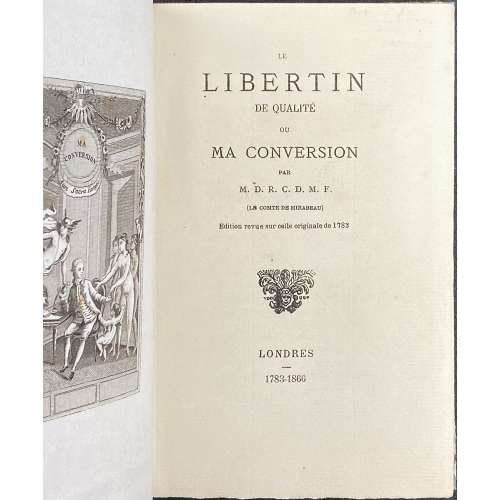 Hardcover volume, 17 x 11.3 cm, in-12, quarter orange cloth (percaline) over marbled boards, black morocco label with gilt lettering to spine, marbled endpapers, text printed on laid paper, five plates on India paper (papier Chine). Title-page: LE | LIBERTIN | DE QUALITÉ | OU | MA CONVERSION | PAR | M. D. R. C. D. M. F. | (LE COMTE DE MIRABEAU) | Edition revue sur celle originale de 1783 | {fleuron} | LONDRES | – | 1783-1866 || Pagination: [4] (h.t., t.p.), [1] 2-200; total 204 pages plus 5 engraved plates, incl. frontispiece; 2 blank leaves at the front and 2 at the back, laid paper, watermarked Canson & Montgolfier. Catalogue raisonné: Dutel I: A-653. Ref.: Illustrations were earlier published in Vie privée, libertine et scandaleuse de feu Honoré-Gabriel Riquetti Comte de Mirabeau, 1791, (see [LIB-2633.2021] Apollinaire, et al. L’Enfer de la Bibliothèque nationale, 1912 : № 795). M. D. R. C. D. M. F stands for Monsieur de Riqueti comte de Mirabeau Fis. Catalogue Poulet-Malassis & ses amis description: № 55. M. D. R. C. D. M. F. (le comte de Mirabeau). Le Libertin de qualité ou Ma conversion, édition revue sur celle de l’originale de 1783. Londres 1783-1866 [Christiaens, 1867]. In-12 de 2 .n.ch. et 200 pages, demi-percaline orange, pièce de titre, tête jaspée, tranches naturelles (reliure de l’époque). Illustré de 5 gravures originales, dont l’une en frontispice, qui reprennent celles de l’édition de Vie privée libertine et scandaleuse de feu Honoré-Gabriel-Riqueti, ci-devant comte de Mirabeau [...] de 1791. Contributors: Honoré-Gabriel Riqueti de Mirabeau (French, 1749 – 1791) – author. Alexis Christiaens (Belgian, d. 1880) – publisher.
Hardcover volume, 17 x 11.3 cm, in-12, quarter orange cloth (percaline) over marbled boards, black morocco label with gilt lettering to spine, marbled endpapers, text printed on laid paper, five plates on India paper (papier Chine). Title-page: LE | LIBERTIN | DE QUALITÉ | OU | MA CONVERSION | PAR | M. D. R. C. D. M. F. | (LE COMTE DE MIRABEAU) | Edition revue sur celle originale de 1783 | {fleuron} | LONDRES | – | 1783-1866 || Pagination: [4] (h.t., t.p.), [1] 2-200; total 204 pages plus 5 engraved plates, incl. frontispiece; 2 blank leaves at the front and 2 at the back, laid paper, watermarked Canson & Montgolfier. Catalogue raisonné: Dutel I: A-653. Ref.: Illustrations were earlier published in Vie privée, libertine et scandaleuse de feu Honoré-Gabriel Riquetti Comte de Mirabeau, 1791, (see [LIB-2633.2021] Apollinaire, et al. L’Enfer de la Bibliothèque nationale, 1912 : № 795). M. D. R. C. D. M. F stands for Monsieur de Riqueti comte de Mirabeau Fis. Catalogue Poulet-Malassis & ses amis description: № 55. M. D. R. C. D. M. F. (le comte de Mirabeau). Le Libertin de qualité ou Ma conversion, édition revue sur celle de l’originale de 1783. Londres 1783-1866 [Christiaens, 1867]. In-12 de 2 .n.ch. et 200 pages, demi-percaline orange, pièce de titre, tête jaspée, tranches naturelles (reliure de l’époque). Illustré de 5 gravures originales, dont l’une en frontispice, qui reprennent celles de l’édition de Vie privée libertine et scandaleuse de feu Honoré-Gabriel-Riqueti, ci-devant comte de Mirabeau [...] de 1791. Contributors: Honoré-Gabriel Riqueti de Mirabeau (French, 1749 – 1791) – author. Alexis Christiaens (Belgian, d. 1880) – publisher. -
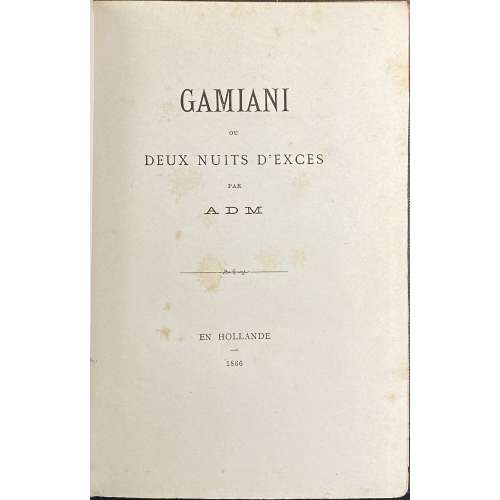 Single volume, 18 x 12.5 cm, bound in ¾ crimson morocco over marbled boards, gilt double-fillet borders, spine with gilded raised bands, gilt in compartments, gilt-lettered label, marbled endpapers, top margin gilt, text printed on dense wove paper, with 8 etchings by anonymous on thin laid paper (Chine) with tissue guards, after original lithographs by Devéria and Henri Grévedon or Octave Tassaert for the 1833 edition (1926 re-print LIB-3135.2023); the plate with the ape after 1864 edition (LIB-3087.2022) and the plate with the donkey after unknown. Title-page: GAMIANI | OU | DEUX NUITS D’EXCES | PAR | A D M | — | EN HOLLANDE | – | 1866 || Pagination: [4] (h.t., t.p.), [i] ii-xvi, [3] 4-153 [154 blank]; total 158 pages plus 8 plates (anonymous etchings), incl. frontispiece. Catalogue raisonné: Dutel I: A-470; Pia: 518/9. BNF Enfer 418. Note: This edition is conformant with Dutel, but not with Pia, who mentions [2], xvi, 148 pp. Pia writes: 'According to a bibliographic record published in 1874 by Vital Puissant, this edition was printed in Brussels by Briard on behalf of Alphonse Lécrivain, a Parisian publisher who took refuge in Belgium'. Catalogue Poulet-Malassis & ses amis description: № 74. [Alfred de MUSSET] A D M. Gamiani ou deux nuits d’excès. En Hollande, 1866. In-8 de xvi, 153 pages, demi-maroquin cerise à coins, dos à nerfs orné, lets dorés sur les mors, tête dorée, tranches naturelles, couverture conservée (reliure ancienne). Illustré de 8 gravures sur Chine dont l’une en frontispice, toutes accompagnées de serpentines. Piqûres et mouillures. Dutel A-470, pas à l’Enfer de la BnF.
Single volume, 18 x 12.5 cm, bound in ¾ crimson morocco over marbled boards, gilt double-fillet borders, spine with gilded raised bands, gilt in compartments, gilt-lettered label, marbled endpapers, top margin gilt, text printed on dense wove paper, with 8 etchings by anonymous on thin laid paper (Chine) with tissue guards, after original lithographs by Devéria and Henri Grévedon or Octave Tassaert for the 1833 edition (1926 re-print LIB-3135.2023); the plate with the ape after 1864 edition (LIB-3087.2022) and the plate with the donkey after unknown. Title-page: GAMIANI | OU | DEUX NUITS D’EXCES | PAR | A D M | — | EN HOLLANDE | – | 1866 || Pagination: [4] (h.t., t.p.), [i] ii-xvi, [3] 4-153 [154 blank]; total 158 pages plus 8 plates (anonymous etchings), incl. frontispiece. Catalogue raisonné: Dutel I: A-470; Pia: 518/9. BNF Enfer 418. Note: This edition is conformant with Dutel, but not with Pia, who mentions [2], xvi, 148 pp. Pia writes: 'According to a bibliographic record published in 1874 by Vital Puissant, this edition was printed in Brussels by Briard on behalf of Alphonse Lécrivain, a Parisian publisher who took refuge in Belgium'. Catalogue Poulet-Malassis & ses amis description: № 74. [Alfred de MUSSET] A D M. Gamiani ou deux nuits d’excès. En Hollande, 1866. In-8 de xvi, 153 pages, demi-maroquin cerise à coins, dos à nerfs orné, lets dorés sur les mors, tête dorée, tranches naturelles, couverture conservée (reliure ancienne). Illustré de 8 gravures sur Chine dont l’une en frontispice, toutes accompagnées de serpentines. Piqûres et mouillures. Dutel A-470, pas à l’Enfer de la BnF. -
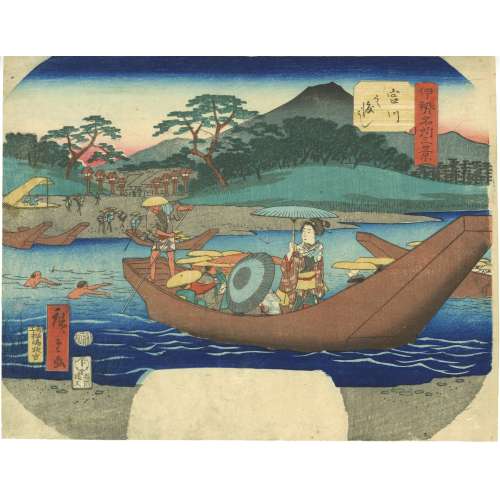 Artist: Utagawa Hiroshige II (二代目 歌川広重] (Japanese, 1826 – 1869). Signed: Hiroshige ga. Publisher: Enshūya Matabei [遠州屋又兵衛] (Japanese, fl. c. 1768 – 1881); (Enmata [遠又]), seal 22-009 (Marks). Block carver: Matsushima Masakichi (Japanese, fl. c. 1847-65); seal: [松嶋彫政] – Hori Masa (Frieze, 2009: 142). Combined date seal and kiwame censor seal: Bunkyū 2 (1862). Media: Fan print (uchiwa-e, 団扇絵), 230 x 298 mm Series: Three Famous Views in Ise [伊勢名所三景] (Ise meisho sankei).
Artist: Utagawa Hiroshige II (二代目 歌川広重] (Japanese, 1826 – 1869). Signed: Hiroshige ga. Publisher: Enshūya Matabei [遠州屋又兵衛] (Japanese, fl. c. 1768 – 1881); (Enmata [遠又]), seal 22-009 (Marks). Block carver: Matsushima Masakichi (Japanese, fl. c. 1847-65); seal: [松嶋彫政] – Hori Masa (Frieze, 2009: 142). Combined date seal and kiwame censor seal: Bunkyū 2 (1862). Media: Fan print (uchiwa-e, 団扇絵), 230 x 298 mm Series: Three Famous Views in Ise [伊勢名所三景] (Ise meisho sankei). -
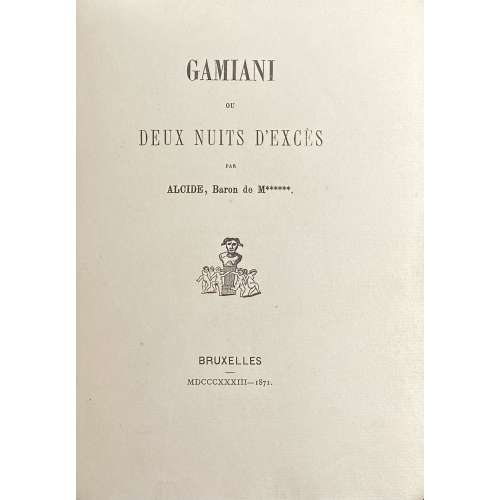 Single volume, 19.2 x 14.2 cm, bound in ¾ dark blue morocco over peacock marbled boards, gilt double-fillet border, spine with gilded raised bands, gilt fleurons and lettering, marbled endpapers, top margin gilt, outer margin uncut; text printed on watermarked laid paper; frontispiece by Félicien Rops, plates by Félix Lukkow after original lithographs by Devéria and Henri Grévedon or Octave Tassaert for the 1833 edition (1926 re-print LIB-3135.2023); the plate with the ape may be considered 'after edition of 1864' (LIB-3087.2022). Collation: π2 (h.t., t.p.) [a]8 1-712 96, total 64 leaves plus etched frontispiece in sanguine after page 8 and 12 engraved plates on India paper; illustrations include six burin engravings printed in two versions each, black and red, all six by Félix Lukkow after Devéria and Grévedon. Pagination: [4] [i] ii-viii, [1] 2-116, total 128 pages, ils. Title-page: GAMIANI | OU | DEUX NUITS D’EXCES | PAR | ALCIDE, Baron de M******. | {publisher's device} | — | BRUXELLES | MDCCCXXXIII—1871. || Limitation: Print run of 150 copies of which one unique on peau de vélin, 130 on laid paper (papier vergé), 5 on papier album jaune, 4 on papier de Chine, 10 on papier fort de Hollande. This is copy № 3, on Van Gelder laid paper, watermarked (possibly this is what they call ‘papier fort de Hollande’). Catalogue raisonné: Dutel I: A-472; Pia 520. Ref.: BNF Enfer 66. Contributors: Alfred de Musset (French, 1810 – 1857) – author. Félicien Rops (Belgian, 1833 – 1898) – artist. Félix Lukkow (French, fl. c. 1870 – 1875) – engraver. Vital Puissant (Belgian, 1835 – 1878) – publisher. Catalogue Poulet-Malassis & ses amis description: № 58. [Alfred de MUSSET - Félix LUKKOV] Alcide, baron de M******. Gamiani ou Deux nuits d’excès. Bruxelles, M DCCC XXXIII - 1871 [Vital Puissant]. In-8 de 2 .n.ch, viii, 116 pages, demi-chagrin bleu à coins, dos à nerfs orné, lets dorés et à froid sur les mors, tête dorée, tranches naturelles, non rogné (reliure de l’époque). Illustré de 7 gravures sur Chine, dont une en frontispice, en double état (sauf le frontispice) par Félix Lukkov, d’après les gravures de Félicien Rops. Tirage à 150 ex. L’un des 10 ex. tirés in-8, sur grand papier fort de Hollande (n° 3). Bibliographie : Pia 561, Per 16-14, Enfer 66, Dutel A-472.
Single volume, 19.2 x 14.2 cm, bound in ¾ dark blue morocco over peacock marbled boards, gilt double-fillet border, spine with gilded raised bands, gilt fleurons and lettering, marbled endpapers, top margin gilt, outer margin uncut; text printed on watermarked laid paper; frontispiece by Félicien Rops, plates by Félix Lukkow after original lithographs by Devéria and Henri Grévedon or Octave Tassaert for the 1833 edition (1926 re-print LIB-3135.2023); the plate with the ape may be considered 'after edition of 1864' (LIB-3087.2022). Collation: π2 (h.t., t.p.) [a]8 1-712 96, total 64 leaves plus etched frontispiece in sanguine after page 8 and 12 engraved plates on India paper; illustrations include six burin engravings printed in two versions each, black and red, all six by Félix Lukkow after Devéria and Grévedon. Pagination: [4] [i] ii-viii, [1] 2-116, total 128 pages, ils. Title-page: GAMIANI | OU | DEUX NUITS D’EXCES | PAR | ALCIDE, Baron de M******. | {publisher's device} | — | BRUXELLES | MDCCCXXXIII—1871. || Limitation: Print run of 150 copies of which one unique on peau de vélin, 130 on laid paper (papier vergé), 5 on papier album jaune, 4 on papier de Chine, 10 on papier fort de Hollande. This is copy № 3, on Van Gelder laid paper, watermarked (possibly this is what they call ‘papier fort de Hollande’). Catalogue raisonné: Dutel I: A-472; Pia 520. Ref.: BNF Enfer 66. Contributors: Alfred de Musset (French, 1810 – 1857) – author. Félicien Rops (Belgian, 1833 – 1898) – artist. Félix Lukkow (French, fl. c. 1870 – 1875) – engraver. Vital Puissant (Belgian, 1835 – 1878) – publisher. Catalogue Poulet-Malassis & ses amis description: № 58. [Alfred de MUSSET - Félix LUKKOV] Alcide, baron de M******. Gamiani ou Deux nuits d’excès. Bruxelles, M DCCC XXXIII - 1871 [Vital Puissant]. In-8 de 2 .n.ch, viii, 116 pages, demi-chagrin bleu à coins, dos à nerfs orné, lets dorés et à froid sur les mors, tête dorée, tranches naturelles, non rogné (reliure de l’époque). Illustré de 7 gravures sur Chine, dont une en frontispice, en double état (sauf le frontispice) par Félix Lukkov, d’après les gravures de Félicien Rops. Tirage à 150 ex. L’un des 10 ex. tirés in-8, sur grand papier fort de Hollande (n° 3). Bibliographie : Pia 561, Per 16-14, Enfer 66, Dutel A-472. -
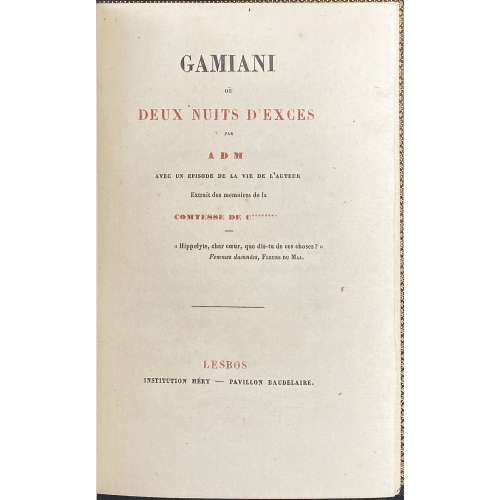 Single volume, 16.8 x 11.3 cm, bound in full dark olive crushed morocco by Brany (signed), gilt triple-fillet border to boards, spine with raised bands, gilt in compartments, gilt-lettered label, gilt dentelle inside, marbled endpapers, all margins gilt, gilt double fillet to boards margin; text printed on laid paper. Bookplate of Maurice Lebarbier de Tinan to fep 45 x 35 mm representing standing satyr with erected penis holding monogram ‘MT’ in his hands with a motto below on a ribbon ‘FAIRE SANS DIRE’. Maurice Lebarbier de Tinan book collection was dispersed via l’hôtel Drouot (Paris) on a sale from March 9 to 12, 1885; a catalogue was published: Catalogue d’un joli choix de livres anciens et modernes, en très belle condition de reliure, composant la bibliothèque de M. L. de T*** [Lebarbier de Tinan] (Paris, Ch. Porquet, 1885, in-8, VIII-140 p., 481 lots). Collation: π2 (h.t., t.p.) a6 b2 1-1112, total 82 leaves plus 18 engraved plates on wove paper; illustrations include engraved frontispiece and six etchings printed in two versions each, black and red, and one etching (at p. 103) in two states, two colour versions for each state, frontispiece and 3 or 4 plates after Félicien Rops, the others after original lithographs by Devéria and Henri Grévedon or Octave Tassaert for the 1833 edition (re-print of 1926 LIB-3135.2023). Pagination: [4] [i] ii-xvi, [3] 4-141 [3], total 164 pages, ils. Title-page (red and black): GAMIANI | OU | DEUX NUITS D’EXCES | PAR | A D M | AVEC UN EPISODE DE LA VIE DE L’AUTEUR | Extrait des mémoires de la | COMTESSE DE C******** | – | « Hippolyte, cher cœur, que dis-tu ces choses ? » | Femmes damnées, Fleurs du Mal. | — | LESBOS | INSTITUTION MERY — PAVILLON BAUDELAIRE. || Catalogue raisonné: Dutel I: A-464; Bory: 596-605; Pia: 516/7. According to Pia, the print run is limited to 150 copies on laid paper. Ref.: BNF Enfer 419. Fekete (Christie's): 135. Provenance: Maurice Lebarbier de Tinan (French, 1842 – 1918). Contributors: Alfred de Musset (French, 1810 – 1857) – author. Félicien Rops (Belgian, 1833 – 1898) – artist. Auguste Poulet-Malassis (French, 1825 – 1878) – publisher. Catalogue Poulet-Malassis & ses amis description: № 5. [Alfred de MUSSET] A D M. Gamiani ou Deux nuits d’excès, avec un épisode de la vie de l’auteur, extrait des mémoires de la comtesse de C********. Lesbos, Institution Méry, Pavillon Baudelaire [A. Poulet-Malassis, 1864]. Illustré de 8 gravures, dont l’une en frontispice, en double état (et quatre états pour la gravure « au singe » de la page 103) de Félicien Rops. Là où Baudelaire soutient Poulet-Malassis quand l’éditeur soutient l’attribution à Musset. Perfectionniste ? Trop cher ? Trop sollicité ? Pas toujours inspiré ? Rops réalisera rarement des suites complètes, ne répondant le plus souvent à la demande de ses commanditaires que par la conception de frontispices. Au verso du faux-titre, Launay voit une justification de 150 exemplaires sur papier vergé, paraphés et numérotés, qui ne figure pas ici. Très bel exemplaire relié par Brany. Provenance : Bibliothèque de Lebarbier de Tinan de Lebarbier de Tinan dont la collection fut dispersée en 1885, justifié par son ex-libris représentant un satyre en érection, portant la devise “Faire sans dire”. Bibliographie : Pia 558, Per 16-8, PC 1299, Lau 285, Enfer 419, Dutel A-464." [LIB-3118.2022]
Single volume, 16.8 x 11.3 cm, bound in full dark olive crushed morocco by Brany (signed), gilt triple-fillet border to boards, spine with raised bands, gilt in compartments, gilt-lettered label, gilt dentelle inside, marbled endpapers, all margins gilt, gilt double fillet to boards margin; text printed on laid paper. Bookplate of Maurice Lebarbier de Tinan to fep 45 x 35 mm representing standing satyr with erected penis holding monogram ‘MT’ in his hands with a motto below on a ribbon ‘FAIRE SANS DIRE’. Maurice Lebarbier de Tinan book collection was dispersed via l’hôtel Drouot (Paris) on a sale from March 9 to 12, 1885; a catalogue was published: Catalogue d’un joli choix de livres anciens et modernes, en très belle condition de reliure, composant la bibliothèque de M. L. de T*** [Lebarbier de Tinan] (Paris, Ch. Porquet, 1885, in-8, VIII-140 p., 481 lots). Collation: π2 (h.t., t.p.) a6 b2 1-1112, total 82 leaves plus 18 engraved plates on wove paper; illustrations include engraved frontispiece and six etchings printed in two versions each, black and red, and one etching (at p. 103) in two states, two colour versions for each state, frontispiece and 3 or 4 plates after Félicien Rops, the others after original lithographs by Devéria and Henri Grévedon or Octave Tassaert for the 1833 edition (re-print of 1926 LIB-3135.2023). Pagination: [4] [i] ii-xvi, [3] 4-141 [3], total 164 pages, ils. Title-page (red and black): GAMIANI | OU | DEUX NUITS D’EXCES | PAR | A D M | AVEC UN EPISODE DE LA VIE DE L’AUTEUR | Extrait des mémoires de la | COMTESSE DE C******** | – | « Hippolyte, cher cœur, que dis-tu ces choses ? » | Femmes damnées, Fleurs du Mal. | — | LESBOS | INSTITUTION MERY — PAVILLON BAUDELAIRE. || Catalogue raisonné: Dutel I: A-464; Bory: 596-605; Pia: 516/7. According to Pia, the print run is limited to 150 copies on laid paper. Ref.: BNF Enfer 419. Fekete (Christie's): 135. Provenance: Maurice Lebarbier de Tinan (French, 1842 – 1918). Contributors: Alfred de Musset (French, 1810 – 1857) – author. Félicien Rops (Belgian, 1833 – 1898) – artist. Auguste Poulet-Malassis (French, 1825 – 1878) – publisher. Catalogue Poulet-Malassis & ses amis description: № 5. [Alfred de MUSSET] A D M. Gamiani ou Deux nuits d’excès, avec un épisode de la vie de l’auteur, extrait des mémoires de la comtesse de C********. Lesbos, Institution Méry, Pavillon Baudelaire [A. Poulet-Malassis, 1864]. Illustré de 8 gravures, dont l’une en frontispice, en double état (et quatre états pour la gravure « au singe » de la page 103) de Félicien Rops. Là où Baudelaire soutient Poulet-Malassis quand l’éditeur soutient l’attribution à Musset. Perfectionniste ? Trop cher ? Trop sollicité ? Pas toujours inspiré ? Rops réalisera rarement des suites complètes, ne répondant le plus souvent à la demande de ses commanditaires que par la conception de frontispices. Au verso du faux-titre, Launay voit une justification de 150 exemplaires sur papier vergé, paraphés et numérotés, qui ne figure pas ici. Très bel exemplaire relié par Brany. Provenance : Bibliothèque de Lebarbier de Tinan de Lebarbier de Tinan dont la collection fut dispersée en 1885, justifié par son ex-libris représentant un satyre en érection, portant la devise “Faire sans dire”. Bibliographie : Pia 558, Per 16-8, PC 1299, Lau 285, Enfer 419, Dutel A-464." [LIB-3118.2022]




